Panic at the Dojo by ProfessorProf
Action Movie Universe
Original SA post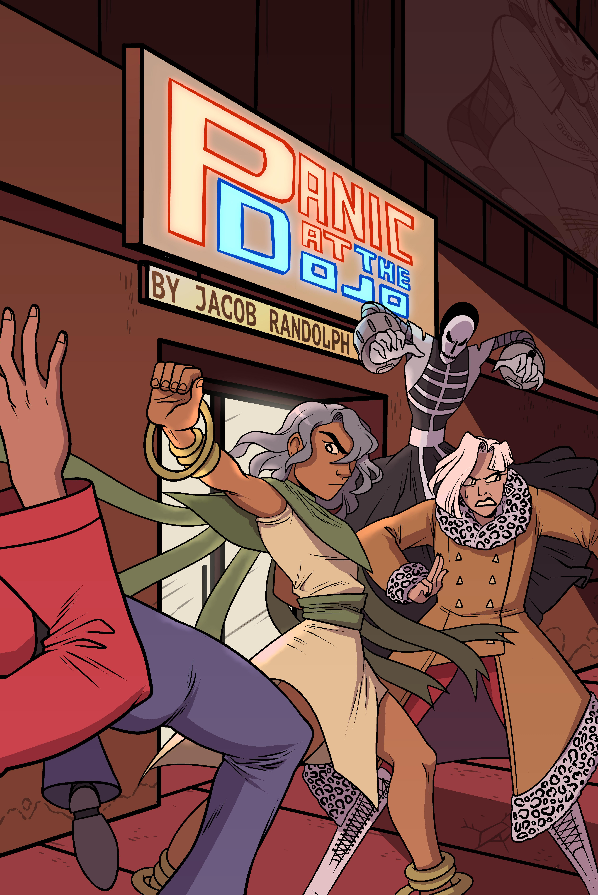
Panic at the Dojo is a brand new (currently only available for kickstarter backers!) indie system that emulates goofy over-the-top martial arts action movies. Kind of like Feng Shui, but with a lot more focus on tactical combat and customizing your own martial arts fighting style. It's pretty neat, and a lot of the mechanics are interesting in ways I've never seen other systems attempt - including an unexpectedly great system for out-of-combat scene resolution. Let's read about it!
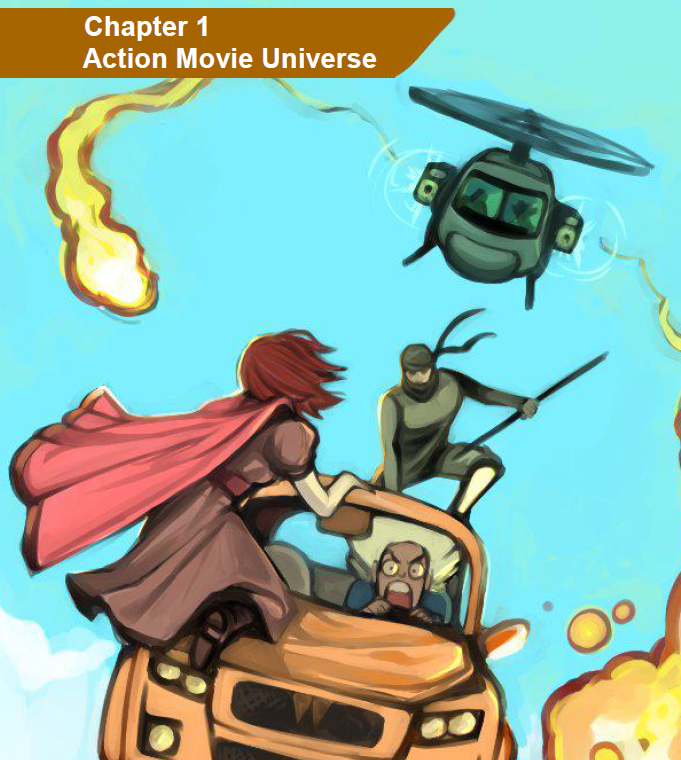
The book opens with an explanation of the kind of universe it's trying to convey. It's a pretty loosely designed world, but we know a few things: Martial arts reign supreme, magic exists a little, people have kung fu battles for extremely petty reasons all the time. Examples listed for inspiration include Jackie Chan Adventures, Kung Fu Hustle, Shaolin Soccer, One Punch Man, and The Last Airbender. In terms of whether it's modern/sci-fi/fantasy/post-apocalyptic, everything is left to the
Flow of Play
Following a quick "how to play tabletop RPGs" page, we move on to an explanation of the intended flow of the game. After chargen, each player introduces their character to the group via a Debut scene, where attendance by other characters is optional and they get to be a huge badass. Then, the party gets together and has a big fight, kicking off the main gameplay loop:
- Motivation to fight.
- Fight scene.
- The winners get what they want.
- The losers make their Last Stand.
- Each hero faces a Trouble or Contest.
- New fights appear on the horizon.
From here, we get a quick rundown of important terms and a glossary, but rather than go through all of that, here's the basic flow of fighting:
- During chargen, you take Forms (main building blocks of combat) and Styles (modifiers to forms to make them more customized), and combine them to make three Stances (a Form + a Style).
- At the start of your turn, you pick a Stance, and the stance defines how you fight for the next round.
- You roll a pile of 3-6 Action Dice of varying sizes, as dictated by your Stance's Form. These become your Action Pool for the round.
- You can use each die in the Action Pool to take one action, either from a list of basic shit everyone can do or from the actions provided by your Stance.
- Some actions can only be performed using an action die that rolled a certain value or higher, and some actions increase in power the higher the value on the die you use for it.
- Actions resolve, combat continues until it stops continuing.
Tactical Combat
Original SA post
Panic at the Dojo: Tactical Combat
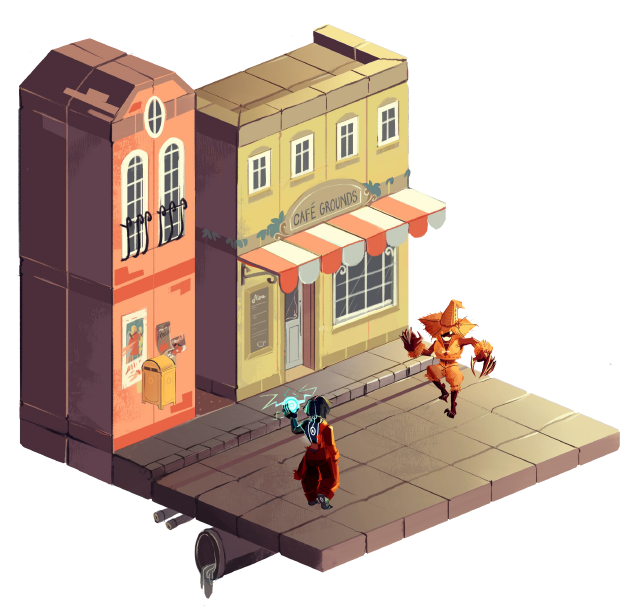
The first thing the book emphasizes in this chapter is not the how of fighting, but the why. Every fight happens for a reason.
quote:
"I want to punch his smug little face so he never talks to me again."
"This is revenge for last time. I want to hurt them."
"My buddy wants to fight, and I've got their back."
"They've got our money, and I need that money real bad."
"They insulted my hair. I like my hair. I need to teach 'em respect."
"If someone doesn't stop them, they'll detonate a bomb inside the white house and kill the president!"
"They crashed my concert, and need to be removed from the venue."
"Nobody messes with the tunnel snakes and gets away with it."
Cinematic Weight
Now we get to the first really interesting bit! When designing encounters, you can fine-tune not only the difficulty, but the Weight of a fight. They don't change the difficulty of the fight, but heavier fights take longer, have higher stakes, and are more complicated, while lighter fights are quick and simple.
There are five weight classes:
Featherweight
Light battles with simple stakes and straightforward mechanics. Blitz tactics are valuable, healing not so much.
- Each Health Bar has 6 HP. This is another weird mechanic - durability of characters is measured in health bars, and all health bars are (generally) the same length. We'll dig more into that later.
- The Heal Value is 2, meaning that healing abilities restore 2 HP by default.
- No Bonuses or Penalties are assigned. More on those later.
Lightweight
This and the next two are all about equal in weight, but different in feel. Lightweight fights are intense but fast, with people going down hard and everyone generally playing a lot of rocket tag.
- Health Bars have 9 HP each.
- Heal Value is 2.
- Each Hero gets the default Bonus of +2 Max HP, but can forego them to give someone else a different bonus, or give one enemy a penalty.
Middleweight
Your standard fight. Offense and defense are in balance, no particular strategy is favored. Like Lightweight, but Health Bars have 12 HP, and Heal Value is 3.
Heavyweight
A big tough slog of a fight, favoring tough fighters over DPS blitz tactics. Like Middleweight, but Health Bars have 14 HP, and Heal Value is 4.
Weight of the World
Your final bosses, your big flashy setpiece fights. Use sparingly, for when you want something to feel massive and awesome.
- Health Bars have 16 HP each.
- Heal Value is 4.
- Each Hero picks a bonus that applies to only them, or a penalty that applies to one enemy. The GM also does this, either giving a bonus to an NPC or giving a penalty to a PC.
Guest Heroes
If I have one main issue with this book, it's that the layout is pretty confusing - there's a bunch of little incidental rules like this before explaining some big important shit like how initiative works. I'm gonna skip a couple of them.
Anyway, allied NPCs! They're built just like PCs, but instead of the GM controlling them, the party collectively decides what they do each turn.
Uneven Fights
So, the basic rule of thumb for fights in Panic at the Dojo is that there's the same number of Health Bars on both sides of the fight. Normally, that means that a party of four PCs = four health bars, and then the enemies add up to four health bars between them. This is tricky if you want to have more than four real NPCs, or if you want to keep the pace of fights interesting, so if you want to adjust the feel of fights on yet another level, add some more health bars! This does NOT, actually, mean that the enemy force is necessarily stronger than the PCs. The golden rule is maintained, so more health bars for the enemies means more health bars for the party as well.
For an example, four PCs, and you want them to fight three warriors and a big tough boss character. Each warrior gets the standard single bar, but to make the boss feel tougher, you decide to give him three bars. That's a total of six bars for the enemy force, so that means that the PCs get six bars, too! That's one each, then two extras, which can be distributed in two ways: Either each PC gets half a bar of bonus HP on their first (and only) health bar, or the party picks two people to give the extra bars to. Or hell, one person to get two extra bars. It's all up to the party.
The book notes in particular that this should always be done for very small fights, because the game doesn't work very well if there aren't at least 3 bars on each side.
Higher Stakes
In fights with higher stakes, lean on bonuses and penalties. The GM can throw bonuses and penalties around willy-nilly, making the fight more complex and crazy - however, there's a similar rule as with health bars at play. The number of bonuses on the PCs + penalties on the enemies must be the same as the number of bonuses on the enemies + penalties on the PCs. So, if you give all four PCs bonuses, you could counterbalance it by also giving four bonuses to one enemy, or two penalties each on two PCs, et cetera. Keep it balanced, otherwise go nuts.
Next time, bonuses, penalties, and last stands.
Combat Part 2
Original SA post
Panic at the Dojo: Combat Part 2
Last time, we learned a lot about how bonuses and penalties are assigned. Now, let's actually talk about what they do!
Bonuses
Small, impactful boosts to your strength that can turn the fight in your favor. These are usually applied at the start of a fight, but can happen in mid-battle, too. I'll try to sum these up, but there's a lot of Rules going on here, so some I'll have to explain later.
Default: +2 Max HP. This is a special bonus, applicable by default in all Light/Middle/Heavyweight fights to all PCs. If you're picking a bonus off the list, then you can't take the default bonus.
Counter: Gain 2 Control Tokens. More on that when we get to Forms.
Defensive: Gain Armor until the end of the round. Armor is a simple on/off switch, and means that all hits against you do 1 point less damage.
Found an Opening: Add a 5 to your Action Pool, which you can save between rounds until you need it. That's effectively having another action die in the pool, but you assume that it rolled a 5.
Freedom: For the rest of the round, gain 2 Speed Tokens at the start of everyone's turn. Speed Tokens are spent to move around the battlefield, and discarded at the end of the turn - but if you have some from an ability like this, you can spend them to move regardless of whose turn it is.
Power Up: Gain 2 Iron Tokens, 2 Power Tokens, and 2 Speed Tokens. More on those later.
Talk Big: Challenge an enemy you can see, then pull them up to 4 spaces towards you. More on Challenges when we talk about tokens.
Tactics: Place four Obstacles onto the battlefield, on any empty spaces. More on those when I get to terrain.
Vigor: Restore HP equal to twice the Heal Value.
Willpower: Gain a 4-point Shield. More on those later.
Penalties
The opposite of bonuses, these make your life harder. They're a bit less general and a bit more specific to certain kinds of builds, which means that they can get a lot nastier.
Burned: Gain 4 Burning Tokens. At the end of your turn, if you have any Burning Tokens, you discard 1 and take 1 damage.
Dazed: You can't use any of the unique actions granted by your Stance this round.
Defenseless: Any shields you have break, and you can't benefit from shields or Armor for the rest of the round.
Enraged: For the rest of the round, when someone damages you, you also get Challenged by them, replacing any outstanding Challenge.
Handcuffed: The fun one. Pick someone within 2 spaces, and pull them adjacent to you. You can now only move to spaces adjacent to your new partner. Forced movement against one moves the other, and you can both use Speed Tokens to move either one of you.
Missed Opportunity: On your next turn, when you roll your Action Dice, discard the highest number.
Power Down: You lose all Basic Tokens you're holding, and can't gain any Power Tokens or Iron Tokens for the rest of the round.
Spotlight: Destroy any Copies you're using. For the rest of the round, enemies can ignore Fog when targeting you.
Trapped: A Trap is placed on your space, and every adjacent space.
The Last Stand
Eventually, one side or the other wins in a fight. This can happen when they all run out of HP, or when they concede. The winners get to win, but the losers aren't out everything - they still get to make a Last Stand. When making their Last Stand, the losing side declares three things:
quote:
1: What do you want most out of this fight?
2: How far are you willing to go to get what you want?
3: What's your last ditch plan to get what you want?
quote:
1: How do you stop their last ditch plan?
2: What punishment do you dish out to them? How much punishment you can give them is dependent on how far they were willing to go - the farther they go, the more you can hurt them for it.
3: What are you willing to give them, and what do you take for yourself?
Next: How to do fighting.
Combat Part 3
Original SA post
Panic at the Dojo: Combat Part 3
All of the stuff up until now was basically tangential rules surrounding fights, how they're set up, and how they resolve. Now, it's time to sink our teeth into the middle bit!
Fights take place on a grid, like D&D 4e and its ilk. Suggested size is between 10x10 and 20x20, with non-square shapes being encouraged as well. Anything off the end of the grid is an Edge.
Free Movement
Movement doesn't take any actions, it just takes Speed Tokens. As long as you're holding any of those, you can move one space in any direction, then discard Speed Tokens - 1 for horizontal or vertical, 2 for a diagonal, +1 if you're moving on to Rubble. You can repeat this any number of times in a turn to get where you want to go, but at the end of every turn, everyone discards every Speed Token they're holding. In practice, this means that having 8 speed tokens means you can move 8 spaces, but there are some quirks to how it's handled here - for example, if you're holding one Speed Token, you can still do a diagonal move onto Rubble, since movement comes before discarding Speed Tokens. Also, you can do your movement in between actions arbitrarily until your turn ends, and if you find a way to pick up new Speed Tokens when it isn't your turn, you can keep moving around. If you want to move during an enemy turn, it has to be at the beginning or end of the turn.
Terrain
The main kinds of terrain you'll be dealing with are Walls and Edges. The GM draws out the arena's general shape, and indicates which parts of the edge are Walls, and which are Edges. Walls block movement, but Edges don't - if you fall off one, you're out of play for the rest of the turn. At the end, you can jump back into the fray at any space along that Edge. Once that's done, though, it's time for the players to spice things up: Each gets to choose one kind of obstacle, and place six continuous spaces of it on any empty spaces on the map.
There's an optional rule for ultra high-powered settings, where any forced movement that pushes or pulls you into a wall destroys the wall, replacing it with rubble, and you keep moving.
Health Bars
As mentioned before, health is measured in Health Bars, which are divided from there into HP. You usually have one bar, but depending on the circumstances and weight of the fight, you might have several. All Health Bars in a scene have the same amount of HP, unless someone has the Default bonus, in which case theirs are 2 HP longer. Damage notably doesn't carry over between Health Bars - if your first of two bars is at 4 HP, and you get hit for 6 damage, the last 2 damage are lost as the first bar breaks. However, if you were hit by an attack that does two hits of 5 damage each, then the first hit would break your Health Bar and the second hit would start on your next Health Bar, for a total of 9 damage.
The Initiative Meter
This thing is pretty interesting and unconventional in terms of how it handles turns. There's no rolling for initiative; instead, you have a track with a number of slots on it equal to the number of Health Bars in the fight. Slots alternate between hero slots and villain slots (the first is always a hero slot), and within the party, you can choose whatever order you want to take your turns. If someone has multiple Health Bars, they can accordingly take extra turns over the course of the round. So, you start with a PC's turn, then the GM picks an enemy to act, and you repeat, until each person has taken a turn for each Health Bar. If the party split up a health bar evenly, then anyone can take that bonus turn during the round.
This gets really interesting when combat gets more complicated or when people get taken out, but we'll save that for later.
The Turn
At the start of the turn, you pick one of your three Stances. Then, you roll a pile of dice, based on your Stance's Form - for example, if your Stance uses the Iron Form, then you roll d8/d6/d6 for your Action Pool on any turn when you're in that stance. Those numbers then become your Action Pool - you don't add them up, just keep the individual numbers that rolled. From there, you spend as many Action Dice as you can on various actions, until you run out or decide you're done. Most actions have a number requirement at the start of their name, like "5+: Rescue" - this means that you can only spend a die that rolled a 5 or higher on that action. If it starts with an X instead, then the power of the action is determined by the value of the die spent on it.
Then your turn is over, and you discard any remaining Action Dice or Speed Tokens, and the ball is passed to the other side's court for the next turn.
Each Stance has one or more Unique Actions associated with it, which can only be used while in that Stance. In addition to those, and a couple other sources to talk about later, your main source of actions is the Basic Action list. These are things that anyone can do, regardless of Stance or condition. Here they are:
X: Movement
Gain X Speed Tokens.
1+: Damage
Deal 1 damage to one enemy in your range.
3+: Deal 2 damage instead.
5+: Deal 3 damage instead, and push them 1 space away.
7+: Deal 4 damage instead, and push them 1 more space.
9+: Deal 5 damage instead, and push them 1 more space.
X: Throw
Choose an adjacent enemy or ally, and push them X spaces.
X: Grapple
Choose an enemy or ally within range, and pull them X spaces towards you.
1+: Open the Path
Destroy one Obstacle within range.
4+: Also destroy Obstacles adjacent to it.
8+: Also destroy Obstacles adjacent to those.
1+ A Challenger Approaches
Challenge an enemy within range 1-4.
2+: Put It Out!
Remove one token from someone in range.
4+: Remove another token.
7+: Remove another token.
4+: Bring it on!
Challenge any number of enemies you can see.
5+: Rescue
Pick an ally within range who's at 0 HP, and heal them. If they aren't in play, they return to play on the space of their choice.
Next: Finally wrapping up these combat rules.
Combat Part 4
Original SA post
Panic at the Dojo: Combat Part 4
We got the basics down last time, and hopefully we can wrap that chapter up this time!
Getting Taken Out
If you fall off an Edge, or run out of health, then you're Taken Out. If everyone on one side of a battle is Taken Out, the fight's over. While Taken Out, you can't take any actions or move, you can't gain or lose tokens, and any ongoing effects on you are on hold. You also can't be targeted by any actions, unless it's a healing action, in which case it can target you and bring your HP back up. If you were Taken Out by HP loss, then you're back in action, but if it was due to an Edge, you're healed but still out.
Coming Back
At the end of the round - that is, a full run through the Initiative track - anyone who fell off an Edge returns to action, placing themselves on any space adjacent to an Edge. Stooges (this game's Minion equivalent) are an exception, and are out for good. Bosses are also an exception - you can throw a Boss off an Edge, but if they're out of play at the start of their turn, they immediately return to play, instead taking 3 damage. The only way to ring out a boss is to KO them with the attack that knocks them off the edge.
Heroic Spirit
Here's where KOs get interesting: If you're Taken Out, your turns still come on the Initiative Track. You can't take any actions, but instead, your heroic spirit can energize your friends to fight harder!
If you're Taken Out at the start of your turn, choose a Stance and roll Action Dice as normal. However, instead of taking actions with them, pick another player, tell them what you want them to do, then give them your Action Pool. Your chosen ally then takes an additional turn, using their Stance but your die rolls. They don't have to do what you tell them to, but you just gave them a free turn, so they might as well hear you out, right?
There's an optional rule where, instead of giving them a full Action Pool, you can discard the two lowest numbers first, then give them a bonus of your choosing (but not the Default).
Obstacles
We've talked about these a couple times, but here's the full list.
Copies: Clones of a character. They occupy a space, and the original can spend Speed Tokens as usual to move them instead of theirself. When the original uses an action, they can have one of their Copies use it instead. Things that happen to a Copy don't happen to the original, and any Tokens they gain are discarded. If a Copy takes damage, it's destroyed immediately.
Edges: Cliffs, pits, or just the edge of the scene. If you are over an Edge, you can spend Speed Tokens immediately to escape from that fate, but if you don't have enough of those, you are removed from play until the end of the round.
Fog: Anyone inside or adjacent to a Fog space can only be targeted at Range 1 by enemies.
Rubble: You can walk over it, but only kind of. Discard an extra Speed Token for each space of movement over Rubble, and forced movement ends on it.
Traps: When you move onto this space, or when someone's turn ends while you're standing on this space, you take 1 damage.
Walls: Blocks movement and line of sight. A wall space can be targeted by an attack, and if it's hit for 2 or more damage, it becomes Rubble.
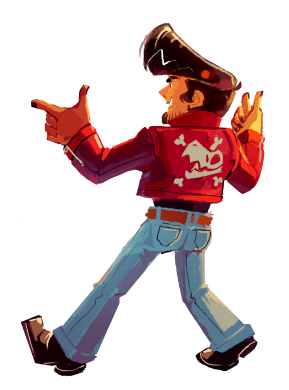
Tokens
As should be clear by now, this game loves its Tokens! There's a ton of different Token types, but there are three types of Basic Token:
Iron Tokens absorb damage for you. Whenever you take damage from an Action, you can spend any number of Iron Tokens to reduce the final damage by that amount.
Power Tokens make your attacks hit harder. Whenever you use an Action that deals damage or pushes, you can spend 1 Power Token to increase its damage by 1 (if it does damage) and increase its push distance by 1 (if it pushes). You can't spend multiple Power Tokens on one attack.
Speed Tokens make you move. You can move as long as you have Speed Tokens, and each space of movement discards them.
There are, however, quite a few other kinds of tokens, some of them unique to specific actions, Forms, or Styles. Some of the more common ones:
Burning Tokens represent how on fire you are. At the end of your turn, if you're holding any Burning Tokens, discard one and take 1 damage.
Weakness Tokens reduce your power. If you deal damage while holding any Weakness Tokens, discard one and reduce the damage by 2.
Challenge Tokens are a bit special - you can only hold one at a time, and each one is associated with the person who gave it to you. While you have one, any action you take that targets people must include them as a target. At the end of your turn, if you damaged the person who gave you a Challenge Token, discard it. If the challenger is removed form play or taken out, you discard it immediately.
Next time: Putting all this shit together into a system.
The Basics
Original SA post
Panic at the Dojo: The Basics
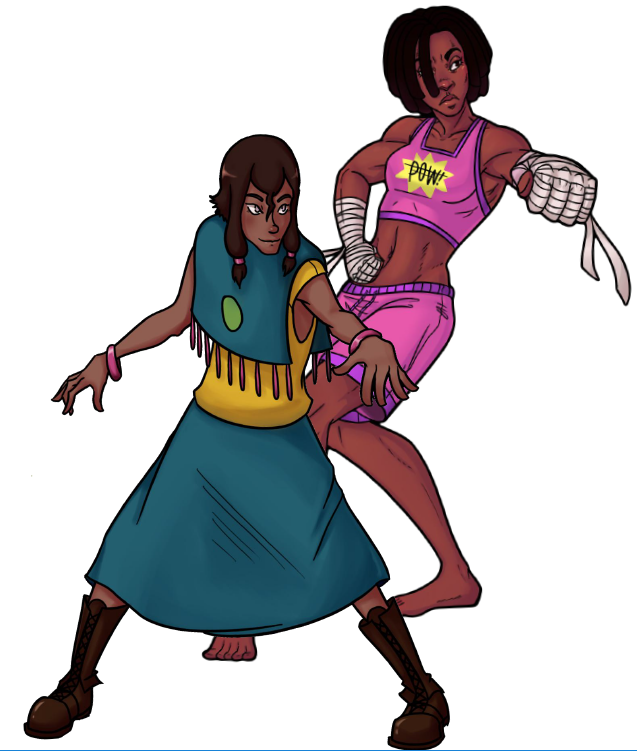
So, we've got all those rules down, but it's time to combine them into a detailed play flow! This involves understanding all of the building blocks of the game: Forms, Archetypes, Styles, Abilities, Actions, and Stances.
Forms
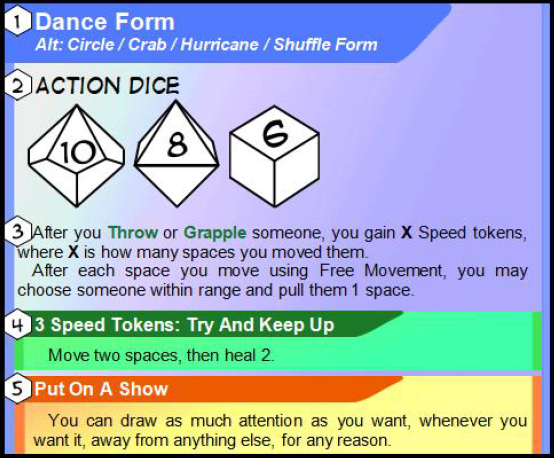
Forms are the basis of combat - there are twelve in total, and each PC picks three of them to build their Stances. Your Stance's Form determines what dice you roll for it, and how many. Beneath that, it lists an Ability, a passive bonus that you have as long as you're in a Stance that uses that form. The green box is one to three Unique Actions that you can use your Action Dice for as long as you're in that Form, and the orange box is a Skill you have if any of your Stances use that form. Skills are for out of combat, we'll talk more about them later.
You may notice that there are several alternative names listed after the main name - this is a fluff thing, so you can make the names of your Stances sound cooler.
Archetypes

Archetypes are sort of like character classes, but a lot looser. The first word of the name will be one of Focused, Fused or Frantic, which are three different versions of each Archetype power (more on that later). At chargen, you pick between one and three Archetypes, and you gain abilities from all of them. Sort of. We'll get back to these in chargen.
Styles
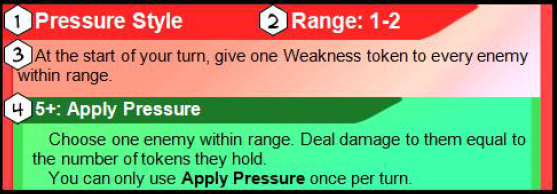
Styles are twists you put on Forms in order to create Stances. Your Archetypes determine which Styles you have access to, and then you pick three of them and combine them with your Forms in order to build your three Stances. Like Forms, they grant Abilities and Unique Actions, but instead of determining your Action Dice, they determine the Range of anything that says "within range" in its description. Each one also comes with a few paragraphs of text explaining its general theme and some Forms or Abilities that it pairs well with.
Form + Style = Stance. The names are combined in the form of "Style Form", so if you used the Vigilance Form in conjunction with the Pressure Style, then you'd create the Pressure Vigilance Stance.
Range
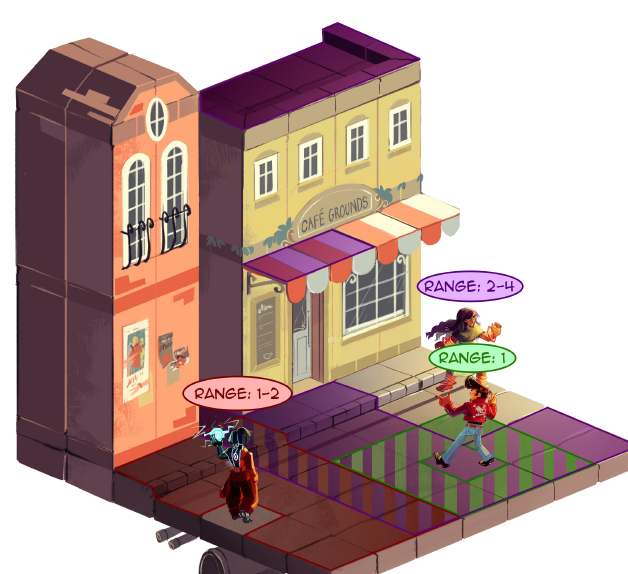
While movement distinguishes straight and diagonal movement, range does not. For whether or not something is in range, go by 4e rules.
Actions
We've seen a few of these, but here's some more details on those! We've seen basic actions, and a few examples of more complex actions by now, and there are a bunch of different types to look out for.
Simple Actions: If you have a die that beats the Cost number: Spend the die, do the action. There are a lot of these, and they're the easiest to use.

Choice Actions: Some actions will list several things the action can do, then ask you to choose one or two of them.

Tiered Actions: These can be a bit tricky to read at first, but they don't choose one of the things based on your roll; instead, you do everything in the action until you reach a number in the text that your spent die isn't high enough for. So, if you spent a 5 on Stand Strong, then you would heal two allies you can see and heal yourself twice. Some Tiered Actions are also Choice Actions, for extra fun and confusion.

Token Actions: No action dice required! Instead, you spend a certain number of Tokens of specific types to do the action.

X Actions: You spend any action die to use the ability, then wherever X appears in the description, replace it with the value of the die.
Next: Time to dig into Forms!
Forms
Original SA post
Panic at the Dojo: Forms
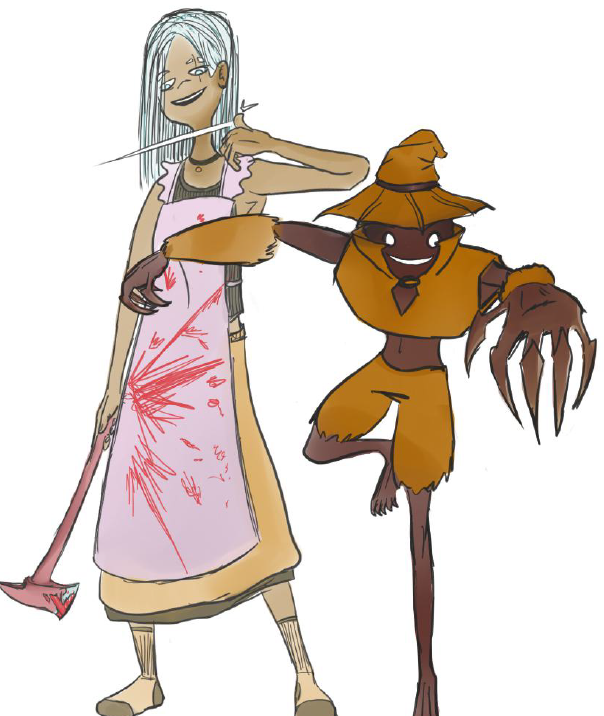
The twelve Forms are the foundation of all combat. Every Stance, every fighting technique has a Form at its core. Forms give you Action Dice, are attached to Styles to form Stances, and contain Skills to dictate what you can or can't do outside of battle.
There are twelve Forms, which I'll go through in more detail: Blaster, Control, Dance, Iron, One-Two, Power, Reversal, Shadow, Song, Vigilance, Wild, and Zen. Each has a name, four alternative names, a set of Action Dice, one or more Unique Actions, an Ability, and a Skill.
In alphabetical order!
BLASTER FORM
(a.k.a. Dragon Form, Dynamo Form, Gold Form, Star Form)
Action Dice: d8/d8/d8
As the name suggests, Blaster specializes in doing wide area damage and fighting multiple enemies at once. While in the form, your Actions all get an extra target within range, and the Style you pair it up with gets its max range increased by one. If you have something that targets, say, one enemy and one ally within range, that means you could either target one extra ally or one extra enemy. Blaster Form's Skill is Basically Magic - pick one supernatural ability, like telekinesis or lycanthropy, and write it down for use in non-combat scenes.
3+ Amplify
Your next Action this turn has its range increased by 2 and can apply to 3 extra targets.
3+: Shockwave
Deal 1 damage to every enemy within range.
6+ Deal 2 damage to one enemy within range.
CONTROL FORM
(a.k.a. Blizzard Form, Gravity Form, Owl Form, Watch Form)
Action Dice d10/d8/d6/d4
This is the main use of Control Tokens. Whenever an enemy in your range takes an Action, you can spend a token to negate it completely, or spend two to redirect it, choosing all of its targets yourself. Also, the paired Style gets either +3 max range or sets its minimum range to 1. The skill is Professional - you always look like you're in control, and when you give orders, people follow them..
3+: Suppression
Gain 1 Control Token and move 1 space.
6+: Gain 1 Control Token.
9+: Gain 1 Control Token and move 1 space.
Remember, for tiered actions, you do everything listed up until the first number higher than your roll. So, if you spend a 7 on Suppression, you gain two Control Tokens and move 1 space.
DANCE FORM
(a.k.a. Circle Form, Crab Form, Hurricane Form, Shuffle Form
Action dice: d10/d8/d6
Dance is all about mobility. Every time you move a space, you can pick someone - ally or enemy - and pull them a space. Every time you throw or grapple someone, you can move a space for each space you move them. Skill is Put On A Show - you can always draw as much attention as you want, for any reason, away from anything else.
3 Speed Tokens: Try And Keep Up
Move 2 spaces, then heal 2. This isn't Free Movement, so it doesn't proc the Dance Form's movement abilities.
IRON FORM
(a.k.a. Fortress Form, Mountain Form, Turtle Form, Void Form)
Action Dice: d8/d6/d6
The ultimate tanking form. You have Armor, so every attack against you does 1 less damage. You're incredibly tough, but also extremely slow - every time you gain Speed Tokens, half of them are replaced with Iron Tokens, which let you reduce incoming damage. Skill is Unmovable - when you hold your ground, nothing can move you or get past you.
3+: Secure
Choose two: Gain 3 Iron Tokens, give 2 Iron Tokens to someone within range, or heal someone within range.
3+: Contain
Choose two: Pull an enemy 2 spaces, Challenge an enemy you can see, or place a Trap on a space within range.
6+: Protect
Choose four from the last two lists.
ONE-TWO FORM
(a.k.a. Chaos Form, Drill Form, Hound Form, Sky Form)
Action Dice: d6/d6/d4/d4
Your go-to multi-hit combo form, specializing in doing lots of small hits each turn. Whenever you do damage with an Action, you hit them again for 1 damage. Skill is Think Fast - you can fast-talk anyone into going along with your plan, and you never lose at games of skill.
1+: Slide In
Teleport 2 spaces.
4+: Whirlwind
Deal 1 damage to 3 enemies within range.
POWER FORM
(a.k.a. Blade Form, Rage Form, Sun Form, Tiger Form)
Action Dice: d10/d10/d4
Slow, hits like a truck. Works kind of like Iron Form - every time you gain Speed Tokens, you replace half of them with Power Tokens. Also, while other Forms can only spend one Power Token per hit, you can spend up to three, making an attack do +3 damage and pushing the target 3 extra spaces. Skill is Unstoppable - you can bust through any door, wall, or vehicle.
3+: Yell
Gain 3 Power Tokens.
6+: Crush
Deal 3 damage, and it can't be reduced in any way - Armor doesn't absorb it, Shields don't block it, Iron or Weaken Tokens can't reduce it, Abilities can't be used in response to it.
9+: There's no upper limit on how many Power Tokens you can spend on this attack.
That's half the forms! Next up, the other half.
Forms 2
Original SA post
Panic at the Dojo: Forms 2
Six down, six to go.
REVERSAL FORM
(a.k.a. Panic Form, Scorpion Form, Time Form, Tornado Form)
Action Dice: d8/d8/d6/d4
This is a weird one, but a cool one. Reversal Form means you can only take one Action per turn, but your Action Pool and Speed Tokens persist between turns and rounds. So, you only toke one Action per turn, but that includes the turns of your allies and the turns of your enemies. You take your turn slowly and steadily throughout the round. Also, for fun, you have Armor. Skill is Perfect Timing - you're always in the right place at the right time, and you can catch or stop anything thrown directly at you.
1+: Counter Attack
Teleport adjacent to an enemy within range who just attacked you, then use the die spent on this Action on another Action targeting them.
SHADOW FORM
(a.k.a. Moon Form, Silence Form, Silver Form, Snake Form)
Action Dice: d4/d4/d4/d4/d4/d4
Shadow Form is all about quick, slippery movement and tricks. In addition to having more dice than any other Form, you get 2 free Speed Tokens at the start and end of your turn. Your speed tokens aren't discarded at the end of a turn, so you can spread your movement all around the initiative tracker. Skill is Shadow Walker - if you don't want to draw attention to yourself, nobody will ever notice you sneaking around.
3 Speed Tokens: Stunt
Place a Fog, Copy or Trap in an adjacent space, then teleport two spaces. Remember that token-based Actions don't use up any action dice, so this is in addition to your other six actions, as long as you have the Speed Tokens for it.
SONG FORM
(a.k.a. Melody Form, Symphony Form, Remix Form, Wave Form)
Action Dice: d8/d6/d6/d4
Here comes the bard! This is a pure support Form, as one might expect. At the start of your turn, you pick a song: Iron, Power, or Speed. You get 3 of that kind of Basic Token, and every ally in range gets 1. Skill is Natural Charisma - anyone who isn't your enemy is your friend.
1+: Sing Along
Pick an ally you can see. Choose one: They remove one Token they're holding, they heal, or they gain 2 tokens from your current song.
4+: They also choose one from the same list.
6+: Add a 4 to their Action Pool - it must be used on an action immediately.
VIGILANCE FORM
(a.k.a. Bear Form, Eternity Form, Heart Form, Moment Form)
Action Dice: d6/d6/d6/d6
This is the ultimate defensive Form, keeping yourself healthy and debuffing enemies while healing allies. At the start of your turn, you either heal or discard one token. At the end of your turn, you give one Weakness Token to an enemy in range. Skill is Eyes Wide Open - you cannot be surprised, ever, by anything.
1+: Bow Down
Give a Weakness Token to one enemy within range.
4+: Give two Weakness Tokens to one enemy within range.
1+: Stand Strong
Heal yourself or an ally you can see.
4+: Heal yourself or a different ally you can see.
WILD FORM
(a.k.a. Beast Form, Platinum Form, Soul Form, Storm Form)
Action Dice: d10/d6/d6
The Wild Form thrives on having your back to the wall. At the start of your turn, add a d6 to your Action Pool if you're under half HP, someone on your team is Taken Out, or you're holding a non-Basic Token. These stack, for potentially up to d10/d6/d6/d6/d6/d6 if all three are true. Skill is Wind Runner - You can jump to anything you can see, run along walls, outrun cars, and even fly if you can justify how that works.
2 Basic Tokens: Fury
Deal 1 damage to an enemy within range. At the end of this turn, push that enemy 1 space. Can only be used 3 times per turn.
ZEN FORM
(a.k.a. Lotus Form, Mantis Form, Spiral Form, World Form)
Action Dice: 7/5/3/1
That's right, Zen Form doesn't roll any dice, ever. Instead, you get a pre-determined 7, 5, 3 and 1. For their mechanics, let's talk about Shields. A Shield is, effectively, a bonus health bar on top of your normal health bars. When you take damage, your Shield takes it instead. When the Shield reaches 0 HP, it breaks, and is gone. Unlike normal health bars, Shields can't be healed, and damage carries over if they get overkilled. You can only hold one Shield at a time.
That last bit isn't true for the Zen Form, though. You can hold multiple Shields at once. If one breaks, the next Shield doesn't activate until the end of the current turn. As an added bonus, whenever an enemy breaks your shield, you deal 1 damage to them. Skill is Peaceful Heart - your soothing voice can calm wild beasts, unruly mobs, and anyone acting out in anger.
3+: Focus
Gain a 2-point Shield, move 1 space.
7+: Gain a 4-point Shield, move 2 spaces. Yes, this means that if you use your 7 on Focus, you get two Shields.
That wraps it up for the Forms! Next up: Archetypes and Styles.
Archetypes - Angel, Cavalry, Cyborg
Original SA post
Panic at the Dojo: Archetypes - Angel, Cavalry, Cyborg
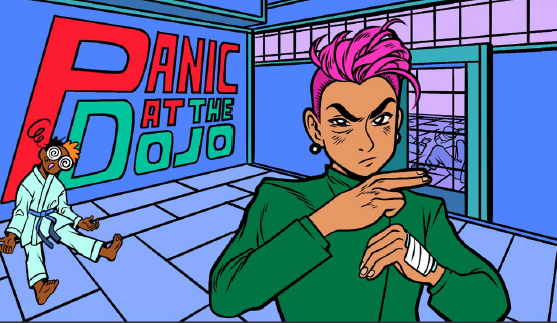
So, we've covered Forms. In order to build a Stance, you combine a Form with a Style to create a unique fighting technique. So, you'll be picking three Forms, then three Styles to attach to them. Styles are sorted into Archetypes - there are 13 of those, then each one has 5 Styles. Which ones you have access to is... a little complicated. OK, this took me a long time to figure out, because the book saves the actual Chargen rules until way later, so here's an explanation from further ahead in the book. When you make a character, you pick what kind of hero you're making - Focused, Fused, or Frantic.
Focused heroes pick one Archetype, and use only Styles within that one Archetype. This sounds like a losing proposition, but each Archetype also has its own special passive ability, and each Archetype Ability comes in three flavors. The Focused version is, generally speaking, the strongest and most dependable.
Fused heroes pick two Archetypes, and combine them together. Your Styles consist of two from one Archetype and one from the other. The Fused Archetype Abilities are the weakest type, but that's because you benefit from both Archetypes' Abilities at all times.
Frantic heroes pick three Archetypes, and get weirder from there. Your Style selection is two Styles from two of your selected Archetypes, then one Style that can be from any other Archetype, even one you don't have. Unlike Focused/Fused heroes, you don't even make Stances! Instead, at the start of your turn, you pick one Archetype, one Form, and one Style, and then you have access to the Abilities and Actions from the ones you picked. The catch: You can't use the same Archetype, Style or Form as you used last turn. Frantic Archetype Abilities are about on par with Focused Abilities, but they're sometimes tweaked slightly to work better as something you only sometimes have access to.
So. There you go. It's time to see what we're working with here.
ANGEL
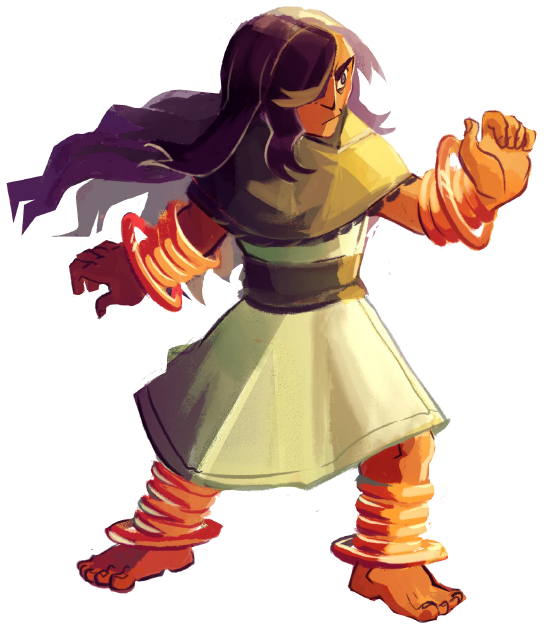
Embodiments of law, purity and order. Angels are defenders and controllers, doing low damage but keeping themselves and their allies alive. They're the main tanking archetype, heavily using Challenge tokens and having Styles full of ways to stay alive while fighting large numbers of enemies.
Each Archetype lists a 'complexity' rating, from one to three stars, kind of like Overwatch. Angel's listed at two stars.
Abilitiy
Focused: At the start of your turn, Challenge an enemy you can see, then deal 1 damage to them, then heal 1. After you Challenge an enemy, deal 1 damage to them, then heal 1. The first half does trigger the second half, so the start-of-turn Challenge does 2 damage and heals 2, and any other Challenges deal 1 damage and heal 1.
Fused: Same as Focused, but without the second half.
Frantic: At the start of your turn, Challenge an enemy you can see, then deal 2 damage to them, then heal 2.
Halcyon Style
Range: 1-2
The invincible debuff manager. At the start of your turn, discard a token. If you discard tokens through Actions or Abilities, you turn them into Iron Tokens instead.
1+: Purify
Remove one token token from yourself or an ally within range.
3+: Remove two tokens from someone within range.
6+: Do 3+ again.
A nice thing the book does for Styles is give some rules clarifications and suggested Stances for each Style. For Halcyon, extra token removal can come from Vigilance Form or Song Form, Blaster Form can expand your Purify to remove up to 13 tokens at once, giving you 13 Iron Tokens for one die. Zen Form can guarantee you a 6+ Purify every turn.
Judgment Style
Range: 1
An aggressive Challenge tank, good at picking one enemy and keeping them from doing things other than fighting you. Whenever an enemy has a Challenge from you, they discard the lowest die from their Action Pool at the start of their turn.
5+: Denial
Teleport next to an enemy you can see, then Challenge them.
Good Stances: Judgment Power uses Denial to move and compensate for its low mobility. Judgment Iron/Reversal gets Armor to soak all the damage you're taking from Challenging people. Judgment Control combines Denial and Control Tokens to remove multiple actions to an enemy. Judgment Zen guarantees access to Denial every turn and lets enemies just break themselves against your shields.
Shining Style
Range: 1
A strange style where you grab allies, pull them next to you, then yell "Never talk to me or my son again". At the start of your turn, all obstacles and enemies adjacent to you are pushed one space. Enemies can't move into spaces adjacent to you.
1+: Beacon
Pull an ally up to 3 spaces. You and that ally heal 1.
4+: The ally heals.
Good stances: Shining Dance/Vigilance/Song create large zones of safety and mass healing. Shining Control/Blaster let you attack without getting into melee range of an enemy.
Singing Style
Range: 2-4
Our Shield tank. Gain a 2-point Shield at the start and end of your turn, and after each Action, increase the health of your active Shield by 1.
Symphony
A weird action - it's technically a Token Action, but instead of using tokens, you spend your active Shield, destroying it. Choose two: Pull an lly 3 spaces, an ally within range heals, Challenge an enemy within range, an enemy within range is pushed 3 spaces, destroy an obstacle within range.
Good stances: Snging Zen lets you hold multiple Shields at once, performing multiple Symphonies in a row. Singing Dance lets you stack powerful Shield boosts while moving and healing. Singing Shadow/Wild let you take huge numbers of Actions to boost your Shield strength.
Winged Style
Range: 1-2
Angels can fly, right? Go ahead and fly. Edges can't remove you from play, and you move two spaces at the end of every turn.
1+: As The Crow Flies
Teleport 3-4 spaces.
Good stances: Winged Power/One-Two can use the added mobility to get in someone's face to delivery those strong hits. Winged Reversal can use the off-turn movement to get into position for counter attacks. Winged Shadow can be basically anywhere at any time.
CAVALRY
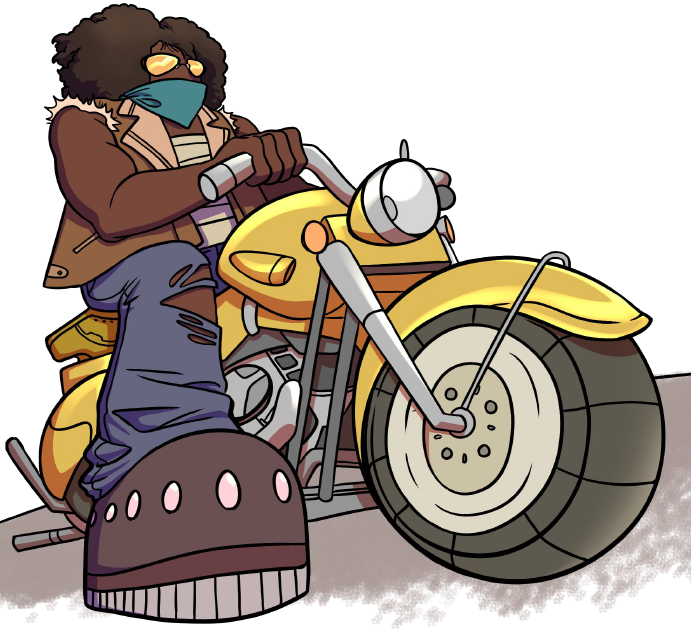
The Cavalry's job is to get where they need to be, fast, and pick the team back up. They're built around support and team buffs, and are highly dependent on good positioning. Complexity: One star.
Ability
Focused: At the start and end of your turn, you and each ally adjacent to you gets a 2-point Shield. When you or an ally get their Shield broken, gain a Speed Token.
Fused: At the end of your turn, you and each adjacent ally get a 2-point Shield.
Focused: First half of the Focused ability.
Charging Style
Range: 1
Get the whole team moving, then get the whole team fighting at once. Whenever you or an ally starts their turn, they can move 2 spaces.
3+: Follow My Lead
Move one space, then deal 1 damage to an enemy within range. An ally you can see gets to do the same.
Good Stances: Charging One-Two Can trigger the extra hits off of Follow My Lead. Charging Blaster gives Follow My Lead an extra action for the attack AND for the bonus ally movement/attack. Charging Shadow potentially lets you use Follow My Lead a ton of times every turn. Charging Reversal uses Follow My Lead during enemy turns to help your allies slip into position more easily.
Heroic Style
Range: 1-2
A tank style that keeps your party alive at the cost of their own survival. Whenever an ally within range takes damage, you take half of it for them.
4+: Burning Heart
You gain 2 Iron Tokens, as does every ally within range.
Good stances: Heroic Iron/Reversal gives you Armor to survive the extra damage. Heroic Reversal/Shadow can get you into range to protect allies off of your turn. Heroic Zen lets you deal damage to enemies when they break your many shields. Heroic Control gives Burning Heart a range of 5.
Jumping Style
Range: 1
Cavalry has to be in the right place, and good lord, Jumping Style will get you there. At the start and end of your turn, teleport 1-3 spaces.
4+: Leap In
Teleport up to 3 spaces, deal 2 damage to an enemy in range.
Good stances: Jumping Power/One-Two increase the damage you can blitz onto an enemy with your leaps. Jumping Blaster helps you charge into groups of enemies and Shockwave them down. Jumping Wild is a chaotic panic stance. Jumping Vigilance Puts you in position to heal or debuff, then back out again.
Rallying Style
Range: 1
When the team is dying, this is the style to get them back on their feet. At the end of your turn, you and every ally in range heals. At the start of each ally's turn, if they're in your range, they heal.
2+: Group Up
Pull an ally up to 3 spaces.
3+: Pull an ally up to 4 spaces.
5+: Every pulled ally heals.
Good stances: Rallying Song/Vigilance maximizes healing strength. Rallying Iron keeps your healer alive. Rallying Blaster/Control increases your Range to make max use of the style's Ability.
Unbreakable Style
Range: 1-2
Buff allies indirectly by buffing yourself! After each Action, give an Iron Token to an ally within range. Allies within range can spend your Tokens directly as if they were theirs.
4+: Eyes Open
Gain 6 Iron Tokens and 1 Weakness Token.
Good stances: Unbreakable Control increases the range for allies using your tokens, and also lets allies play with your Control Tokens. Unbreakable Power/Iron produce large numbers of cool tokens for your allies to use. Unbreakable Shadow/Reversal Let you keep your Speed Tokens between turns, so that your allies can use them.
CYBORG
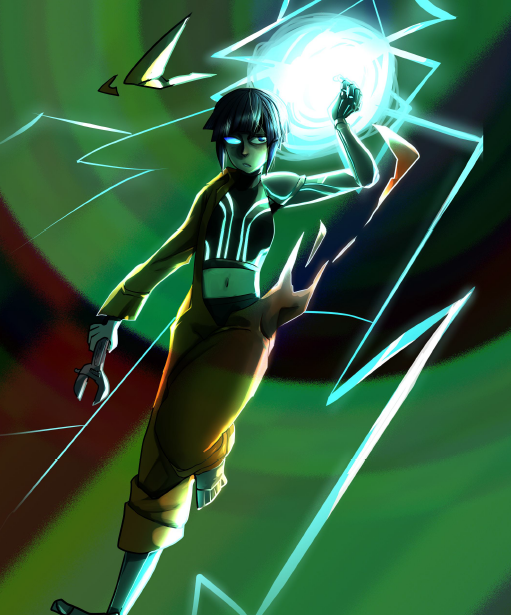
Cyborgs are a slightly strange archetype with a few different themes woven together. They start weak, but build power over time. They get a constant flow of basic tokens, then use them to fuel powerful Token Actions. They can adapt to any situation, becoming stronger, faster, or tougher as needed.
Focused Ability: At the start of your turn, gain four Basic Tokens of any one type.
Fused Ability: Same as Focused, but two instead of four.
Frantic Ability: Same as Focused.
Armored Style
Range: 1-2
A tanky cyborg that soaks damage and keeps enemies from getting away. Every time you spend any number of Iron Tokens, you heal 1.
2 Iron Tokens: You, Stay
Challenge an enemy within range. They discard three Speed Tokens. This does count as spending Iron Tokens for the passive ability.
Good stances: Armored Iron is an obvious tanky pick. Armored Shadow/Reversal Lets you stick to enemies as they move. Armored Vigilance is a very strong stance for keeping yourself alive. Armored Song gives you an insane number of Tokens of whatever type you want.
Incinerator Style
Range: 1-3
All burn. Whenever you spend Power Tokens to boost an attack, it also puts a Burning Token on them.
2 Power Tokens: Flamethrower
An enemy within range takes 1 damage, gains 1 Burning Token, and is pushed one space. If you spend a Power Token, it does get a second Burning Token stacked onto it.
Good stances: Incinerator Power lets you spend multiple Power Tokens on Incinerator. Incinerator One-Two/Blaster give you extra hits, and therefore extra chances to add tokens. Incincerator Song gives you many Power Tokens to play with.
Machine Style
Range: 1-2
The ultimate in versatility. While in this style, Basic Tokens are just Basic Tokens - you can spend any of them as if they were Power, Speed or Iron Tokens as you see fit.
1+: High Efficiency
Choose 3: Heal 1, gain an Iron Token, gain a Power Token, gain a Speed Token, deal 1 damage to an enemy within range.
4+ Do all five things instead.
Good stances: Machine Shadow/Reversal keep Speed Tokens between turns, which you can then spend as Iron/Power Tokens. Machine Shadow/Wild get lots of dice that can all be used for High Efficiency. Machine Song gives you more Tokens. All the Cyborg Styles do well with Song Form, honestly. Just make a kung fu vocaloid like you always wanted.
Rocket Style
Range: 1
A mobility style that's all about battlefield control. After you push anyone, you can teleport to any empty space adjacent to them.
2 Speed Tokens: Rocket Tackle
Push an adjacent enemy or ally two spaces.
Good stances: Rocket Dance lets you move people, teleport to them, then have tons of Speed Tokens left over. Rocket Shadow/Reversal let you Rocket Tackle during other people's turns. Rocket Song give token.
Syphon Style
Range: 1/2
Amasses power gradually over time, then does a huge amount of damage. At the end of your turn, choose a token you hold. Either replace it with a Power token, or gain a copy of it.
2+: Power Converter
Choose a token that you or someone within range is holding. Steal, replace it with a Power Token, or do both.
6+: In addition to affecting the target token, it also affects all other tokens of the same type that that character is holding.
Good stances: Syphon Power/Wild can use all those Power Tokens you're getting quickly and effectively. Syphon Blaster lets you steal a ton of different tokens at once - an Amplified 6+ Power Converter can steal five types tokens from anyone in range and give them to you as Power Tokens. Syphon Reversal can steal enemy Speed Tokens the instant they gain them. Syphon Zen can always do a 6+ Power Converter, every turn. Syphon Song do big tokens.
Next: Demon, Flametongue, Gunkata.
Archetypes - Demon, Flametongue, Gunkata
Original SA post
Panic at the Dojo: Archetypes - Demon, Flametongue, Gunkata
Did you forget I was doing this? So did I!
DEMON
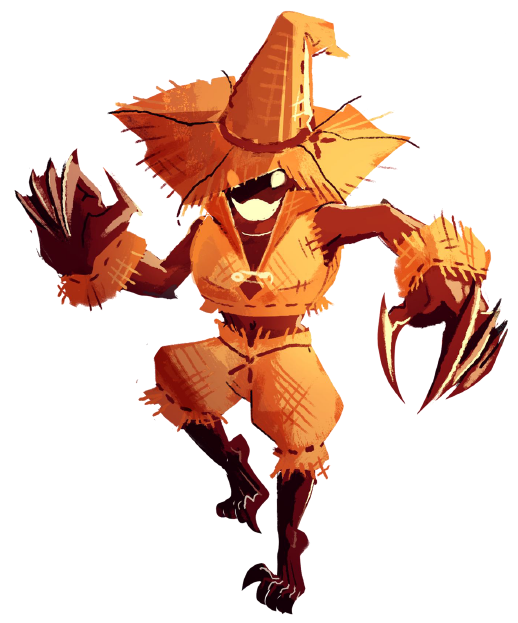
Demons are aggressive harriers who bully opponents to death. They make it hard for you to do anything, push you around, and generally make one person's life a living hell. Their gimmick is Chaos Tokens, which let them take actions during other people's turns. Complexity: 3 stars.
Focused Demon Ability: At the end of your turn, gain 2 Chaos Tokens.
Frantic Demon Ability: At the end of your turn, gain 1 Chaos Token.
Frantic Demon Ability: Same as Focused.
Dark Style
Range: 2-4
The Batman style, sort of. They're built around Fog - you aren't affected by it when picking targets, and at the end of your turn, the space you're standing on becomes Fog. For reference, Fog means that anyone in it or adjacent to it can only be targeted in melee range.
4+: Darkness Dawns
Place Got into two empty spaces within range, then you can teleport into one of them.
4+: Twilight Sorrow
For each enemy standing in (or adjacent to) Fog, you gain one Speed Token and that enemy gains one Weakness Token.
Good stances: Dark Shadow can use their Stunt action to place even more fog, and keep their bonus Speed Tokens between turns. Dark Blaster can place extra Fog on each action, and lets you use Shockwave on fogged targets. Dark Control's expanded range lets you teleport at even longer distances.
Ogre's Style
Range: 1-2
A positioning-based style built around the Throw basic action. Any time you use Throw, it can target any number of enemies within range, and it does 1 damage to each target on top of that.
3+: Watch Your Step
Deal 2 damage to an enemy within line of sight who's moved during this turn. That's any turn, so you can use Chaos Tokens to punish enemies moving during their own turns, too.
Good stances: Ogre's Dance turns your Throws into massive numbers of Speed Tokens. Ogre's One-Two deals an extra point of damage on each Throw. Ogre's Reversal can snipe moving enemies without using Chaos Tokens. Ogre's Blaster can Throw a ton of enemies at once, then Amplify Watch Your Step to damage all of them. Ogre's Control lets you Throw everyone within 5 spaces in all directions.
Slasher Style
Range: 1
An offensive style built around staying close to enemies and damaging them repeatedly. At the end of every turn, you can deal 1 damage to someone adjacent to you, so you can can stick to someone who already took their turn and hit them over and over again.
4+: Suddenly...
Teleport into an empty space adjacent to someone who has nobody else adjacent to them.
Good stances: Slasher Reversal/Shadow can move out of turn to stick to fleeing enemies. Slasher Power/Song give you more Power tokens to enhance your passive damage. Slasher Iron lets you both pull enemies into your range and survive long enough to do good damage while in the thick of things.
Vampire Style
Range: 1
Exactly what it says on the tin. Heal 1 after every time you deal damage with a hit, and whenever you inflict Weakness Tokens, you gain the same number of Power Tokens.
4+: Life Steal
Deal 2 damage to an enemy in range, then give them one Weakness Token.
Good stances: Vampire One-Two/Blaster deal lots of extra hits, letting them heal more often. Vampire Vigilance has lots of ways of inflicting Weakness Tokens. Vampire Zen is a slightly unintuitive but powerful one - every time an enemy breaks one of your shields, you deal 1 damage to them, which activates your healing ability, making it so that enemies who try to hurt you end up healing you instead.
Zombie Style
Range: 1
A relentless style that's almost impossible to keep down. Has Armor inherently, and if your HP is 3 or less at the start of your turn, you heal. This includes being at 0 HP, so you can keep getting back up and continuing the fight as long as you stay in the stance.
4+: Hunger
Deal 2 damage to an enemy within range, then take one of their tokens.
Good stances: Zombie Vigilance lets you heal twice every turn. Zombie Wild can get tons of tokens from staying at low health and using Hunger, then channel all of them into Fury.
FLAMETONGUE
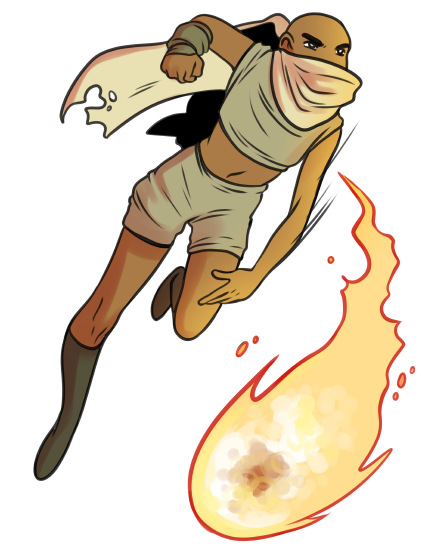
The Flametongue archetype is about fire. You'll set everything around you ablaze, zone enemies out of position, cover everything in tokens, and cover everything else in traps until the enemy can't even get to you, let alone fight back. Their biggest vulnerability is to enemies skilled at removing tokens. Complexity: 1 star.
Focused Flametongue Ability: Whenever you damage an enemy with an Action, give them a Burning Token.
Fused Flametongue Ability: The first time you deal damage to an enemy during your turn, give them two Burning Tokens. If you damage multiple enemies at once, just pick one of them.
Frantic Flametongue Ability: Same as Focused, but it only procs of the target has 2 or less Burning Tokens on them.
Burning Style
Range: 2-4
The most straightforward "All Burn" style. Whenever you target an enemy with an Action, they get a Burning Token, unless they already had four or more.
4+: Burn It All Down
Give a Burning Token to an enemy within range, and also put a Trap into their space.
Good stances: Burning Shadow/One-Two/Dance gives you a lot of hits per turn, which translates into a lot of fire. Burning Blaster sets half the battlefield on each attack. Burning Iron gives you protection from your own Traps.
Explosion Style
Range: 2-4
A huge, dramatic style where your attacks tear open holes in the battlefield itself. Whenever you destroy an obstacle, it's replaced by an Edge. Whenever you damage an enemy, you also push them one space.
6+: Ka-Boom!
Deal 2 damage to an enemy within range, then destroy every obstacle adjacent to them.
Good stances: Explosion Blaster is a gimme, wiping out huge swaths of the battlefield. Explosion Power/One-Two lets you massively push enemies. Explosion Dance uses mobility and the Edges you create during battle to ring out enemies constantly.
Inferno Style
Range: 1-2
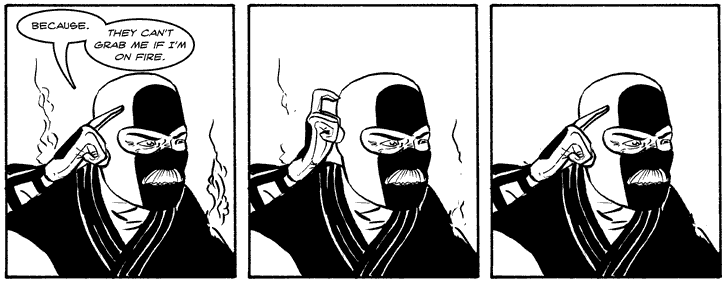
A personal favorite. At the end of your turn, after Burning Tokens trigger, you gain three Burning Tokens. Whenever an enemy deals damage to you with an Action, they get all of your Burning Tokens.
Gain 1 Burning Token: Ignition
That's right, it's a Token Action that gives you tokens, rather than spending them. Can only be used once per turn. Give one Burning Token to an enemy within range.
Good stances: Inferno Blaster lets you multiply your Burning Tokens when giving them to other people. Inferno Shadow lets you keep setting people near you on fire, even if they try to run away. Inferno Wild gets bonus action dice from being on fire. Inferno Zen is hell for anyone you challenge, since if someone breaks your shield, you damage them AND set them on fire.
Phoenix Style
Range: 1
A style best paired with other Flametongue stances, to keep from getting consumed by your own fire. If you have Burning Tokens, they heal you instead of hurting you each turn. Traps also heal you instead of hurting you.
4+: Cleansing Fire
Choose two: Give someone in range a Burning Token, heal an ally within range, place a Trap within range.
Good stances: Phoenix Vigilance is a great self-heal stance for getting back into the fight. Phoenix Song/Iron are good burning support stances, Phoenix Shadow can use Stunt to place a trap, then stand in it to heal up.
Volcanic Style
Range: 1-3
Burning Tokens are already handled by Burning and Inferno, so here's the Traps stance. You don't take damage from moving through Traps (but you do take damage if you end your turn on one). Whenever you move via spending Speed Tokens, lay down a trap on each space as you leave it.
4+: Pyroclasm
Place three Traps within range, and adjacent to existing Traps.
Good stances: Volcanic Shadow lets you place Traps out of turn as a reaction to enemy action. Volcanic Dance gets a shitload of Speed Tokens. Volcanic Song, same thing. Volcanic Iron/Reversal can't be hurt by Traps.
GUNKATA
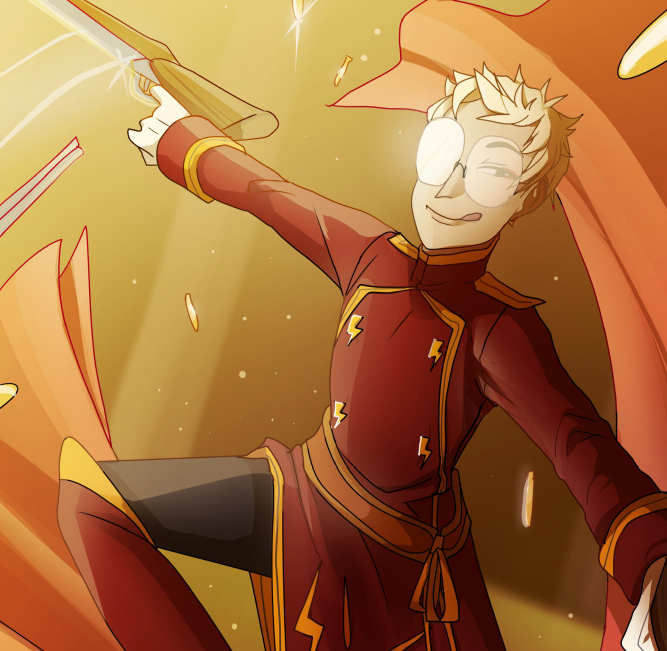
The ancient art of shooting people in the face. A death-by-a-thousand-cuts archetype, Gunkata is all about doing damage loads of times, to loads of guys. They have a major downside, though: Styles in this archetype have minimum range, making positioning important and Fog a nightmare to deal with. Complexity: Two stars.
Focused Gunkata Ability: At the start of your turn, push every adjacent enemy one space, then move one space. At the end of your turn, deal 1 damage to each enemy in range.
Fused Gunkata Ability: Only the end-of-turn half of the Focused ability.
Frantic Gunkata Ability: At the end of your turn, move one space, then deal one damage to each enemy within range, then move one space.
Akimbo Style
Range: 3-5
Dive sideways with pistols. After you deal damage to someone, move one space. This movement is NOT optional. If you damage multiple people, you move multiple spaces.
4+: Firing Wild
Choose one: Deal 1 damage to everyone adjacent to you, or deal 1 damage to everyone in range. This affects allies as well as enemies.
Good stances: Akimbo One-Two doubles Firing Wild's effectiveness, both in terms of damage and movement. Akimbo Control can have a Range of 3-8(!) or 1-5. Akimbo Reversal lets you use the passive ability to move in the middle of an enemy turn, even without any Speed Tokens.
Artillery Style
Range: 3-8
Long-range, blasty violence, covering the enemy lines with chaos from far away. You can see targets through Fog and Walls.
1+: Bombardment
Place a Trap on a space within range.
6+: Place traps into all spaces adjacent to that one.
Good stances: Artillery Control can have a Range of 3-11(!!) or 1-8. Artillery Power can dish out massive damage at massive range. Artillery Blaster doubles the inconvenience of Bombardment. Artillery Shadow can cover the battlefield in Fog for you to hide in at no penalty. Artillery Zen can use 6+ Bombardment every turn.
Crosshair Style
Range: 4-8
A sniper - slow, steady, absolutely ruthless. Weakness Tokens? Iron Tokens? Armor? Shields? None of them can reduce your damage. You always hit at full power.
1+: Take Aim
Your next Action this turn has every number increased by one. That includes damage, push distance, cost, token quantities, and even the number of things you get to choose off of lists.
Good stances: Crosshair Blaster can use Take Aim, Amplify and Damage together to hit six targets at range 4-12(!!!). Crosshair One-Two/Power take advantage of defense piercing to do heavy damage. Crosshair Control can gain double Control Tokens from Suppression while also dropping your minimum range to 1. Crosshair Iron/Song/Vigilance benefit the most from using Take Aim to pick more things from lists or give more Tokens.
Ricochet Style
Range: 2-4
Bounce bullets off of walls, or people. Whenever you deal damage to an enemy with an Action, you can also deal damage to another enemy within 3 spaces of them. Line of sight for the second target is drawn from the first target.
3+: Trick Shot
Choose one obstacle within range. Deal 2 damage to an enemy within 3 spaces of that obstacle. If you shoot a Wall or a Fog, you can choose the next target as if that obstacle wasn't there.
Good stances: Ricochet One-Two lets you deal damage three times on every attack. Ricochet Wild/Shadow get extra ricochets with their plentiful Action Dice. Ricochet Blaster triggers multiple Ricochets per Action by hitting multiple targets - this makes Shockwave VERY dangerous.
Ten Thousand Style
Range: 2-3
Unload bullets constantly, at everyone, forever. Add d4/d4 to your Action Dice.
2+: Point Blank Shot
Deal 1 damage to an adjacent enemy, then push them one space.
Good stances: Not really any point of listing them all here. Bonus dice are good for everyone. If anyone's counting, though, Ten Thousand Vigilance/Song are the only Forms that have Unique Actions that can trigger on a 1, so that's not a bad idea.
Next: Phantom, Punk, Teacher.
Archetypes - Phantom, Punk, Teacher
Original SA post
Panic at the Dojo: Archetypes - Phantom, Punk, Teacher
PHANTOM
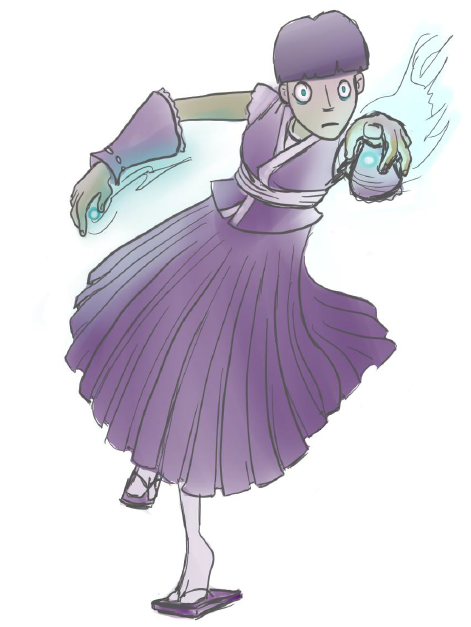
Phantoms are the weird archetype. Their psychic or magical powers give them the ability to adapt to any situation - what they lack in power they make up for in flexibility. They have an answer to every problem, and are pros at ringing out their enemies, but lack any serious offensive power.
Focused Phantom Ability: You always have access to the Unique Actions from all of your Stances, and their costs are reduced by 1, to a minimum of 1+ or 2 tokens.
Fused Phantom Ability: You get the cost reduction, but not the always-available ability.
Frantic Phantom Ability: You always have access to the Unique Actions from all of your stances. While you're in your Phantom stance, their costs are reduced.
Aura Style
Range: 1-3
Shields are the name of the game - give everyone shields, then benefit when they break. You gain a 3-point Shield at the start of your turn. Whenever an enemy within range damages a shield, you can move them one space. Whenever a Shield breaks within range, you gain 1 Iron Token.
3 Basic Tokens: Shield Up
An ally within range gains a 3-point Shield.
Good stances: Aura Zen is the obvious pick for shield stacking. Aura Song/Iron give you good support synergy and more tokens to Shield Up with. Aura Dance/Shadow give you tons of Speed Tokens, which you can then turn into more Shields.
Crying Style
Range: 1-4
An area debuff style that mitigates enemy attacks by weakening huge numbers of enemies. At the start of your turn, give one Weakness Token to all enemies within range. At the end of your turn, Challenge an enemy within range and give them a Weakness Token.
6+: Banshee's Wail
All enemies within range gain a Weakness Token, and all Traps and Walls within range become Rubble.
Good stances: Crying Control boosts your Range to 1-7, making your Weaken effects even more effective. Crying Blaster increases your Range while also offsetting your weak offensive power with Shockwave. Crying Vigilance lets you give even more Weakness Tokens to tough enemies. Crying Zen guarantees a Banshee's Wail every turn.
Puppet's Style
Range: 1-5
Despite the name, you're the puppeteer in this style, not the puppet. When you use Speed Tokens to move, you can instead move any ally, enemy, or non-Edge obstacle within range. If you move a Trap or Wall, they become Rubble.
3+: Pull The Strings
Move an enemy or ally you can see 3 spaces.
5+: Do it again.
Good stances: Puppet's Dance lets you turn Throw and Grapple into Speed Tokens, then spend them to move allies and enemies. Puppet's Control expands the range of your remote movement ability. Puppet's Shadow/Reversal let you keep your Speed Tokens between turns to move enemies throughout the round.
Spirit Style
Range: 1-3
This one's all about summoning phantasmal Copies and using them to fight safely at a distance. Your Copies ignore Edges and Walls, and after you move, you can move any number of Copies one space.
1+: Now You Se Me...
Place a Copy into an empty space within range.
3+: Place another one.
5+: Place another one.
Destroy 1 Copy: ...Now You Don't
Technically counted as a Token Action, but it costs a Copy instead of a token. Teleport into the space of the destroyed Copy.
Good stances: Spirit Shadow lets you move and create Copies constantly and escape from danger easily. Spirit Dance can spread Copies everywhere to trigger its support abilities across the whole battlefield. Spirit Iron/Power can use Copy teleportation to get around their speed penalties.
Vortex Style
Range: 1-3
This is probably the strangest of the Phantom styles, built around opening holes in reality and using them to move around the battlefield at will. Edges can't remove you from play, and when you're standing on an Edge space, you are considered adjacent to (and therefore can move directly onto) any other Edge space.
4+: Black Hole
Place an Edge into an empty space wtihin range. These become portals for you, and bottomless pits for everyone else.
Good stances: Vortex Dance/Shadow/Reversal give you enough speed to exploit all these Edges conveniently. Vortex One-Two/Power/Fury can use Edges to unexpectedly ambush enemies for heavy damage.
PUNK
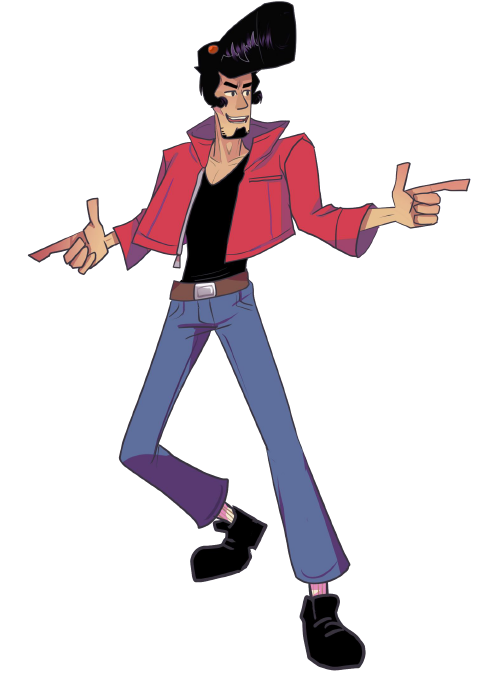
Hey, it's this guy again. Punks are tanks, fighting by outlasting their enemies and hitting harder the more damage they take. Their styles encourage going full aggro and biting off more than you can chew, but if you survive, you can dish out just as much punishment as you took. Complexity: One star.
Focused Punk Ability: At the start of your turn, add a number to your Action Pool with a value of twice the damage on your current health bar, or 1 if it's full.
Fused Punk Ability: Same as Focused, but its value is halved.
Frantic Punk Ability: Same as Focused.
So, if you have a 12-HP Health Bar, but 7 HP on it, then a Fused Punk would add a 5 to their Action Pool, and a Focused or Frantic Punk would add a 10.
Bleeding Style
Range: 1
Tenacity made form - the more damage you take, the harder you fight. If you're at 0 HP, you don't get Taken Out - you can just keep fighting, until everyone on your side is at 0 HP at the same time.
2 HP: Lash Out
Technically a Token Action, but it costs HP instead of tokens. Push an adjacent enemy two spaces.
12+: I'm Still Here
Deal 7 damage to an enemy within range, then push them 7 spaces. No Form gets an Action Die bigger than a d10, so this is generally only usable using the Focused or Frantic Ability. Take as much damage as you can!
Good stances: Bleeding Wild can gain two bonus dice each turn when at 0 HP. Bleeding Blaster can hit multiple enemies at once with I'm Still Here. Bleeding Song can keep you healing allies even while taken out.
Brawling Style
Range: 1
This is all about building up power, then using that power to keep yourself alive. Whenever your Shield breaks, or whenever you deal damage without spending a Power Token, you gain a Power Token.
2 Power Tokens: Tough It Out
Gain a 2-point Shield.
Good stances: Brawling One-Two builds Power Tokens at double speed. Brawling Zen lets you stack multiple Shields for extra Power Tokens, then spend them on more Shields. Brawling Wild can spend Power Tokens on Fury, then gain more Power Tokens from the damage, then spend them on more Fury.
Flashy Style
Range: 1
Another interesting style, this is about doing less things, but doing them extra hard. After you roll Action Dice, you can combine two of the dice into one larger value.
X: Show Off
Perform two of Movement, Damage, A Challenger Approaches, Put It Out!, or Throw, as if you had spent an X on each of them. Can only be used once per turn.
Good stances: Flashy Reversal can get around Show Off's once-per-turn limit by using it on other people's turns. Flashy Shadow/Wild have naturally huge pools of dice to combine. Flashy Power is much more likely than any other stance to be able to pull off a 9+ Crush as needed. Flashy Dance can do some really amazing Throws.
Knockdown Style
Range: 1
Anyone who wants to take you down will pay for it with blood. Whenever an enemy damages you, deal 1 damage to them.
4+: Take It On The Chin
Each enemy within range deals 1 damage to you, taking 1 damage in turn from your ability. Then, deal 3 damage to one of them.
Good stances: Knockdown Zen can set up a shield, then Take It On The Chin to make everyone in your range take 1 damage from hitting the shield AND 1 damage from your Knockdown ability. Knockdown Blaster/Control increase your Range, letting you damage more enemies at once with Take It On The Chin.
Taunting Style
Range: 1
A tanking archetype isn't worth much without an aggro build, right? Whenever you take damage, gain an Iron Token. Whenever you take damage from the enemy with your Challenge, move one space.
1+: Is That All You Got?
Challenge an enemy you can see, then gain an Iron Token.
X: Not Good Enough
Give X-2 Weakness Tokens to your Challenged enemy, and discard the Challenge.
Good stances: Taunting Iron/Vigilance give you tons of Iron/Weakness token synergy. Taunting Reversal/Shadow can move out of turn to avoid the enemy they've taunted.
TEACHER

Another very strange Archetype, the Teacher does little direct fighting - your days of ass-kicking are mainly behind you. Instead, you act as a power multiplier for the rest of the team, donating power and Action Dice to your disciples. Complexity: Two stars.
Focused Teacher Ability: At the end of your turn, gain two Inspired Tokens.
Fused Teacher Ability: Same, but only gain one.
Frantic Teacher Ability: Same as Focused.
Only a Teacher can use Inspired Tokens. You can spend an Inspired Token during an ally's turn to roll a d8 and add it to their Action Pool.
Paitent Style
Range: 1
A strange style that favors holding back for a long time. You can only take one Action per turn, but your Action Pool doesn't empty between turns. At the end of your turn, all your Speed Tokens are turned into Iron Tokens.
X: Waiting Game
Add X+1 to your Action Pool, then move one space. Can only be used during enemy turns.
Good stances: Patient Reversal can use two Actions per turn, one from the Style and one from the Form. Patient Song/Dance get lots of Speed Tokens, which you can then turn into Iron Tokens. Patient Shadow/Wild give you lots of little numbers. Patient Control/Power give you a few big numbers.
Side note on this one - the description in the text seems to suggest that the intent is to build up a bunch of numbers, then blow them all at once for one killer turn, but as written, that seems like it's impossible, because the style doesn't offer any exceptions for the "one action per turn" trait.
Elder Style
Range: 1-2
The style for a master who can still draw on his old skills. Any of the Unique Actions for the Form paired with this style have their costs reduced to 1+ or 2 Tokens. Once per turn, you can use a Unique Action from any style or form for any of your Stances at no cost, as if you spent a 7.
Good forms to have on your other Stances: Blaster Form (Amplify), Iron Form (Protect), Power Form (Crush), Song Form (Sing Along).
Good stances: Elder Shadow can use Stunt for only 2 Speed Tokens, rapidly teleporting around and covering the battlefield in traps.
Bad stances: Elder Reversal has negative synergy, since Counter Attack is unaffected by its cost reduction, and its ability to use unexpected Unique Actions is hampered by the one Action per turn limit.
Mastermind Style
Range: No
Kind of like Warlords in D&D 4e, but even more so. While in a stance using this style, you cannot take any actions. Instead, you make others take actions for you!
After rolling your Action Dice, instead of acting, you use each value to make an ally within line of sight take that Action with that die. It executes as if they had taken that action themselves. Since that means you can't get any Speed Tokens, you move one space after each Action performed by an ally during your turn.
Good stances: Mastermind Vigilance can make your allies weaken enemies for you, even at range. Mastermind Reversal can give anyone's actions to anyone else at any time. Mastermind Iron has Armor and doesn't suffer at all from the Form's speed penalty.
Bad stances: Mastermind One-Two/Power/Zen all have Abilities that do nothing if you aren't taking any actions yourself. Avoid those.
Motivating Style
Range: 1-2
A much more enthusiastic, heroic kind of teacher. At the end of your turn, all allies within range heal, and you get a free Inspired Token.
4+: You Can Do It!
Target an ally in range, choose two: They heal, they move two spaces, they gain a copy of a token they hold, they discard a token they hold.
Good stances: Motivating Dance/Shadow can put you in the position you need to be in to motivate people properly. Motivating Iron has double the defense/support options. The book doesn't list it, but I imagine Motivating Control is also pretty goddamn nice.
Training Style
Lead your allies by example! At the end of your turn, you give one ally a Training Token - this can be spent before performing any Action to increase all of its numbers by one, same as Take Aim last update.
3+: Watch Closely
Gain one Training Token. If you spend it before the turn ends, give an ally one Training Token.
Good stances: Any stance. I guess ones with lots of Action Dice, if you want to be ideal.
Next: Trickster, Underdog, Wanderer, Winterblossom.
Archetypes - Trickster, Underdog, Wanderer, Winterblossom
Original SA post
Panic at the Dojo: Archetypes - Trickster, Underdog, Wanderer, Winterblossom
Final Archetypes update! Then we can move on.
TRICKSTER
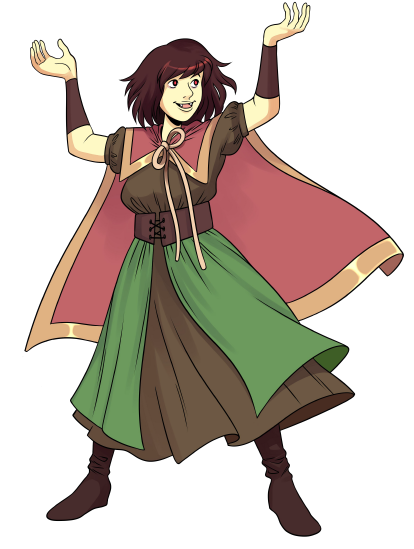
Tricksters are built to confuse and inconvenience enemies at every turn. They change the rules of the game, play with different terrain types, and are hard as hell to pin down. Complexity: Three stars.
Focused Trickster Ability: You can spend any token as an Iron Token. When you spend Iron Tokens to reduce incoming damage, push the attacker 1 space, then move 1 space.
Fused Trickster Ability: Same as Focused, but you don't push them a space.
Frantic Trickster Ability: Same as Focused.
Caged Style
Range: 1
A whole style built around enemy movement denial - if someone is near you, they're near you until you decide to let them go. Enemies adjacent to you can't gain or spend Speed Tokens.
2+: Welcome To My Maze
Deal 1 damage to an enemy outside of your Range, then pull them three spaces toward you.
Good stances: Caged Zen forces nearby enemies to contend with your damaging shields. Caged Iron/Reversal has Armor, to let you use this style for efficient tanking. Caged Blaster lets you pull tons of enemies towards you and then stick them there until they kill you.
Mysterious Style
Range: 1-2
Lots of Trickster styles are built around specific kinds of obstacles - this one is Fog. At the start of your turn, place a Fog into the space you're standing on. While standing in (or next to) Fog, your max range is doubled.
3 Speed/Iron Tokens: Ghost Walk
Cost can be paid with a combination of Speed and Iron Tokens. Place a Fog into an empty space within range, then teleport to a Fog space within range.
Good stances: Mysterious Control increases your foggy attack/teleport range to 10. Mysterious Blaster lets you place more Fog at once, and lets you do a Fog-extended Amplified Shockwave to every enemy within range 10. Mysterious Shadow/Reversal keeps Speed Tokens between turns, making it easier to Ghost Walk during enemy turns. Mysterious Iron makes up for Iron Form's slowness with teleportation, while also giving you more Iron Tokens to use Ghost Walk.
Illusion Style
Range: 1-3
The Copies style. If an enemy damages you while standing within range of one of your Copies, you deal 1 damage back to them (2 damage if they're in range of 3+ Copies). Also, you can spend your Copies as if they were Iron Tokens.
3+: Where Are You Looking?
Place 2 Copies into empty spaces within range.
6+: Do it again.
Good stances: Illusion Control/Blaster give you and your Copies expanded range, making them more dangerous. Illusion Shadow can place Copies in the middle of an enemy turn. Illusion Zen makes attackerse suffer as much as 3 damage for each hit against you.
Hidden Style
Range: 1-3
The Walls style. You can move through or stand inside Walls as if they were empty spaces, and can see and target enemies through walls.
3 Iron Tokens: Sudden Strike
Deal 2 damage to an enemy within range.
Good stances: Basically any of them, really.
Whip Style
Range: 2-5
Not a terrain stance at all, instead zoning enemies by moving them directly. Throw targets one extra person within range, and Throw and Grabble both deal 2 damage in addition to moving the enemy around.
5+: Grapple Hook
Teleport to an empty space within range.
Good stances: Whip Dance makes froced movement so good that it's almost insane to ever use an action other than Throw, Grapple, or Try And Keep Up. Whip Reversal can interrupt enemies and throw them away or grapple away from danger as a reaction to an incoming enemy. The real god tier for this one, though, is Whip Shadow - you get six dice, and even if they roll a 1, you can use all six to throw and deal 2 damage to an enemy, for 12 guaranteed damage every turn.
UNDERDOG
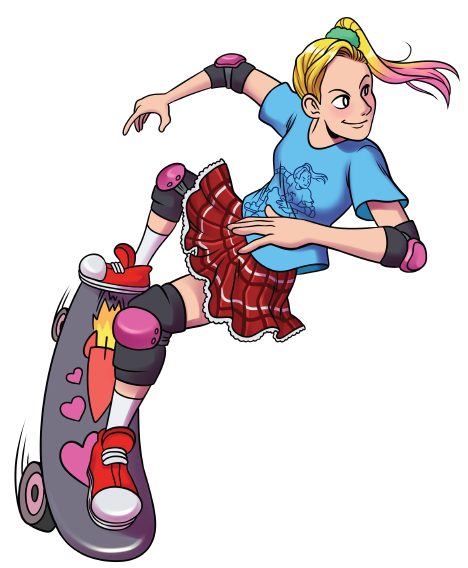
The plucky kid hero. An all-rounder type, not bad at anything and flexible enough to handle any situation. The longer the battle goes on, the more effective they become. Complexity: Three stars.
Focused Underdog Ability: At the start of your turn, gain one of any Basic Token. When you take damage, gain one of any Basic Token.
Fused Underdog Ability: Same as Focused, but you can't gain a Basic Token of a type you already have.
Frantic Underdog Ability: Same as Focused.
Collateral Style
Range: 1-2
Deal property damage, then turn that into your own strength. Every time you destroy an obstacle, you gain a Basic Token.
3+: Roughhousing
Destroy an obstacle within range, then choose one: Teleport to where the obstacle was, deal 1 damage to each enemy adjacent to the obstacle, destroy another obstacle within range. Spend 2 Basic Tokens to choose two from the list, or spend 3 to choose all three.
Good stances: Collateral Blaster lets you destroy multiple obstacles, then apply all the chosen effects to all the obstacles at once. Collateral Control increases the range from which Roughhousing can be used to teleport around.
Distracting Style
Range: 1-2
Makes sure your enemies are always weakened, while also moving all over the place. Whenever an enemy damages you, if they have no Weakness Tokens, they get one. The trick is to Challenge an enemy, then get as slippery as possible afterwards.
1+ or 2 Basic Tokens: Flare
Move one space, then give one Weakness Token to one enemy within range.
Good stances: Distracting Shadow lets you move during enemy turns constantly with Flare and Stunt. Distracting Iron/Zen help you survive all the attention you're drawing. Distracting Reversal gives you Armor and reactions to more easily use Flare on enemy turns. Distracting Vigilance is an all-around powerful recovery stance.
Eye of the Style
Range: 1
Obvious guitar riff goes here. A versatile style that can get whatever advantage they need at any moment. At the start of your turn, you gain a Bonus of your choice.
3+: Thrill of the Fight
Pick a target, then choose one: Challenge them, deal 2 damage, or give them 2 Burning Tokens. Spend 2 Basic Tokens to choose two from the list, or spend 3 to choose all three.
Good stances: Eye of the Shadow can use the Freedom bonus (+2 Speed Tokens at the start of each turn this round) to Stunt and move around the field like crazy. Eye of the Wild can use that or Power Up (Gain 2 of each Basic Token) to use Fury more times in a row.
Lucky Style
Range: 1
You can't kill someone who's lucky. They'll just happen to get lucky and survive. You have Armor, and roll an extra d4 with your Action Dice.
3+: Just What I Needed
Choose one: Gain 2 Basic Tokens, teleport 2-3 spaces, heal. Spend 2 Basic Tokens to choose two from the list, or spend 3 to choose all three.
Good stances: Anything that doesn't already have Armor, but especially Forms that have good actions that can use low rolls - Lucky One-Two/Song/Vigilance are good picks there.
Misfortune's Style
Range: 1-3
Maybe it's not that you're lucky, it's that everyone around you is unlucky. When a Trap triggers underfoot, you can redirect the damage to an enemy within range. If there's no enemy within range, gain a Power Token instead.
1+ or 3 Basic Tokens: Bad Luck
Place a Trap into a space within range.
Good stances: Misfortune's Shadow can use Stunt as an extra way to place Traps. Misfortune's Zen will do 1 damage to nearby enemies constantly. Misfortune's Control makes your Trap damage even easier to apply to multiple enemies.
WARDANCER
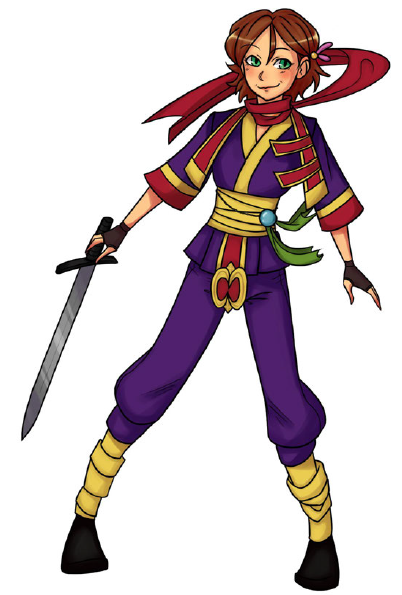
You know what you want, and what you want is to hit someone really hard, really fast. Each Wardancer style gives you a different hammer for violently pounding in a different kind of nail. Easy to play, big numbers. Complexity: one star.
Focused Wardancer Ability: After rolling your Action Dice, either increase all results by 1, or increase one result by 4.
Fused Wardancer Ability: After rolling your Action Dice, increase two of the results by 2.
Frantic Wardancer Ability: Same as Focused.
Forbidden Style
Range: 1-2
Starting out with the crazy one! This is the only style in the game that gets two Forms. You get the Abilities and Unique Actions of both, and a Skill from either one. Action Dice on the main forms are ignored, instead combining two of these:
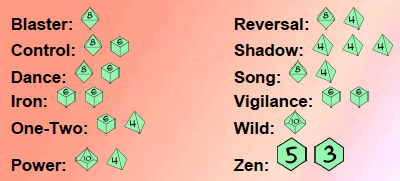
As a drawback, you take 2 damage at the start of your turn, although it can't drop you under 1 HP.
Good stances: Forbidden Power Blaster or Forbidden Blaster One-Two will give you the biggest damage gains. Forbidden One-Two Wild can turn any 2 Basic Tokens into 2 damage. Beyond that, this style is so open-ended that the sky's the limit.
Lightning Style
Range: 1
A super-speedy style that deals damage lots of times to lots of targetse. After you deal damage, you gain a Speed Token.
2+: Deadly Dance
Teleport 2 spaces, deal 1 damage to an enemy within range.
5+: Teleport 2 sapces, deal 2 damage to an enemy within range.
8+: Do 5+ again.
Good stances: Lightning One-Two does damage multiple times on every hit, gaining Speed Tokens on every hit too. Lightning Shadow/Dance can take the free Speed Tokens and plug them into Unique Actions that cost Speed Tokens to use. Lightning Wild is a monster of a stance, refunding one of the two Tokens used on Fury every time you use it. Lightning Zen can use the Wardancer Ability to guarantee a 5+ Deadly Dance and an 8+ Deadly Dance every turn.
Overwhelming Style
Range: 1
Hit once, but hit really hard. Whenever an enemy hits you with an attack, spend a Power Token to push them 1 space and deal 1 damage. Your attacks ignore Armor.
4+: Power Strike
Deal 2 damage to an enemy within range, gain 2 Power Tokens.
8+: Instead deal 4 damage and gain 4 Power Tokens.
Good stances: Overwhelming Power can spend all those Power Tokens at once. Overwhelming Blaster/Wild/One-Two can penetrate armor with their multiple hits to avoid getting shut down. Overwhelming Zen can do two 4+ Power Strikes and an 8+ Power Strike every turn.
Relentless Style
Range: 1
This is all about beating people down and pushing them across the battlefield while you do it. Whenever you damage an enemy, you immediately push them one space and move into the empty space they just left.
3+: Rush Down
Deal 1 damage to an enemy within range. Then, deal 1 damage to an enemy within range.
5+: Then, deal 1 damage to an enemy within range.
7+: Then, deal 1 damage to an enemy within range.
Good stances: Relentless One-Two/Blaster hit multiple times, allowing for more pushing and movement. Relentless Blaster/Control have added range to engage with Rush Down. Relentless Zen's free numbers line up exactly with Rush Down's cost.
Weightless Style
Range: 1
Obstacles are no problem if you just float past them, right? All spaces count as empty to you. Edges can't remove you from play. Rubble doesn't cost extra Speed Tokens. Traps can't hurt you.
4+: Effortless
Teleport to a space you can see.
7+: Target ally can teleport to any space they can see.
Good stances: Weightless Power/Iron can teleport to bypass their mobility issues. Weightless Blaster can reposition multiple allies with Effortless. Weightless Song/Vigilance can escape from any situation to recover.
WINTERBLOSSOM
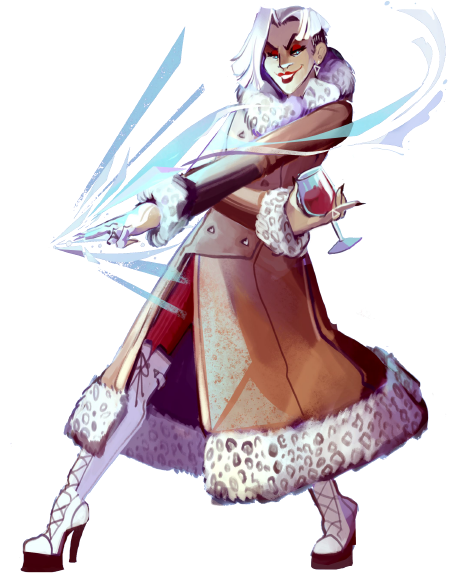
Precise, ruthless, mean. An aggressive debuff archetype that weakens enemies into uselessness, then takes them down with a single powerful attack. Complexity: Two stars.
Focused Winterblossom Ability: At the start of every turn, give a Weakness Token to an enemy within range.
Fused Winterblossom Ability: At the start and end of your turn, give a Weakness Token to an enemy within range.
Frantic Winterblossom Ability: At the start of every turn, give 2 Weakness Tokens to an enemy within range.
Crystal Style
Range: 1-2
Use your own Copies as bombs! Whenever you one of your Copies is destroyed, it deals 1 damage to every enemy adjacent to it.
3+: Splinter
Place a copy into a space within range, then deal 1 damage to every enemyadjacent to it.
6+: Do it again.
Free: Shatter
Counts as a Token Action, has no cost. Destroy a Copy, then give a Weakness Token to an enemy within its range.
Good stances: Crystal Blaster places more Copies per Splinter, and inflicts multiple Weakness Tokens with Shatter. Crystal Shadow can place Copies during enemy turns, then Shatter them instantly. Crystal Control lets you place Copies and dispense Weakness Tokens from far away. Crystal Zen can always Splinter 3 times per turn.
Frozen Style
Range: 1
A defensive stance to punish people who come close to you or try to move past you. Whenever an enemy moves into an empty space adjacent to you, give them a Weakness Token. If they move through your range, that's a Weakness Token for each space of movement within it.
Good stances: Frozen Dance can pull enemies into adjacent spaces and therefore weaken them. Frozen Shadow can Stunt away after an enemy gets into range of you, forcing them to get into range again. Frozen Iron can pull multiple enemies into range, then stay alive with Armor and Iron Tokens.
Precision Style
Range: 1-2
Aim carefully, then hit as hard as you can, make defensive enemies sad. All your Actions deal +1 damage to enemies with Armor or Shields (if they have both, still just +1). Also, whenever you target an enemy, they discard an Iron Token.
3+/3+: Perfect Strike
Requires two numbers from your Action Pool, both of them a 3 or higher. Deals 4 damage to an enemy in range, ignoring Armor and Shields. Tokens and Abilities can't be used as a response.
Good stances: Precision Blaster can make up for the extreme cost of Perfect Strike by hitting multiple targets. Precision Shadow/Wild have lots of Action Dice, which also makes up for the two-die cost. Precision Zen can do a 7+ Focus and a Perfect Strike every turn. Precision Power does insane amounts of damage, ignoring Armor.
Pressure Style
Range: 1-2
Hold this one in reserve for a big finishing attack - the more you've made the enemy miserable, the more you'll ruin their day with this one. At the start of your turn, give a Weakness Token to every enemy in range.
5+: Apply Pressure
One enemy in range takes damage equal to the number of tokens they're holding. Can only be used once per turn.
Good stances: Pressure Vigilance can give enemies tokens and then Apply Pressure on the same turn. Pressure Blaster/Reversal can both cheat through the once per turn limit on Apply Pressure. Pressure Zen gives you a guaranteed Apply Pressure while also using Focus to resist retaliation.
Reflected Style
Range: 2-3
Winterblossom's ultimate defensive option. At the start of your turn, place up to three Walls in empty adjacent spaces. You can see and target enemies through Walls.
3+: Walled In
Place 3 Walls into empty spaces within range 1-3.
3+: Icicle Fall
Deal 1 damage to every enemy who's adjacent to a wall.
Good stances: Reflected One-Two doubles Icicle Fall's damage. Reflected Blaster/Control give you more range, making it easier to attack from behind your wall. Reflected Shadow can teleport to safety if the wall goes down.
Aand with that, we've reached the end of the list! Next up, the stuff you do aside from beating people up with obtuse magical kung fu.
Between Combat
Original SA post
Panic at the Dojo: Between Combat
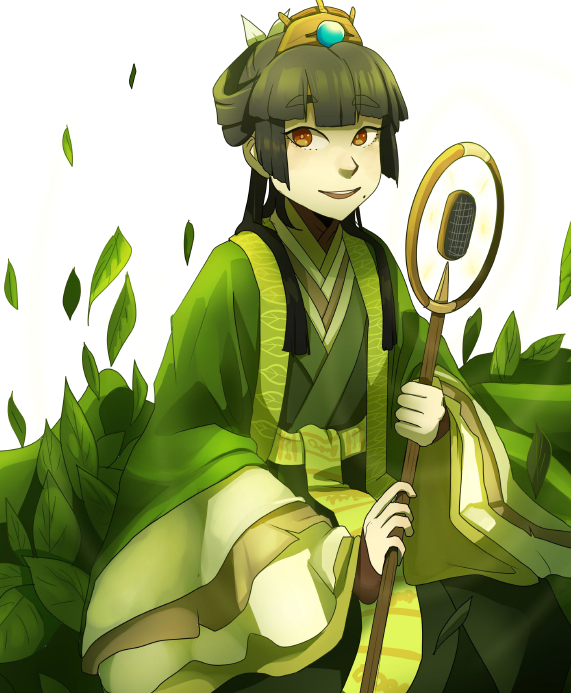
There comes a time in most stories where the violence must stop, and the characters need to do something else - in this case, it's usually getting to more violence. This is based on the Skills covered in the Forms chapter. You get one Skill from each of your Stances (but can swap one out for something else), then write down a two-word description of your character, and that's your fourth Skill. A Skill represents something you can do, like driving a car (Professional) or hiding in shadows (Shadow Walker). There's no dice involved, either you have the Skill and you can do the thing, or you don't, and you can't.
That last sentence is the core idea of the non-combat rules, so, for emphasis: either you have the Skill and you can do the thing, or you don't, and you can't.
The heroes in Panic at the Dojo are not ordinary people. They are extremely good at martial arts, but beyond even that, they're people who are extremely good at a small set of things, and awful at everything else. If you have Unstoppable as a skill, you can charge through walls like the kool-aid man, rip the door off of a bank vault, punch a speeding car out of the way. Doesn't matter how hard it is. You're Unstoppable. If there's a non-combat obstacle in the way, and you have a Skill that can deal with it, good news! You win.
However, if you attempt to do anything that requires even the slightest amount of skill, you don't just fail - you fail catastrophically. You always succeed at the things you're good at, but you also always fail in the biggest, most spectacular ways imaginable when you do something you're bad at. A Professional drives the getaway car and ramps it off of another car to jump over a construction zone, then somehow turns it sideways in mid-air to fit into a cramped alleyway. A vampire who doesn't have any Skills that cover driving drives the getaway car and we smash cut to 3 minutes later as they walk nonchalantly away from a four-way collision that's somehow also on fire.
The important thing about this system is that failure never prevents progress, only impedes it. The vampire from the last paragraph isn't going to die in a car crash - she'll get there eventually, but cause lots of damage on the way there, and possibly have to get the rest of the way there on foot. Success/Failure isn't even quite the right way to talk about these checks; it's less about whether or not you get from A to B and more about how cool or irresponsible that journey ends up being. You're gonna get to the next fight, because without the next fight there's no game here.
PatD is definitely a game built for oneshots (there's no character advancement rules), and it has a pretty codified flow for what a game of it should look like. It goes like this:
- Debut scenes.
- Fight scene.
- Trouble scenes.
- Fight scene.
- Repeat Trouble and Fight until there's nobody left to fight or you're all tired.
Debut Scenes
Before the game proper, each character has an individual Debut Scene, in whatever order the players want. In a Debut Scene, there might be NPCs, there might be other PCs, but they're all optional. The player who's debuting sets the scene, describing some bad situation they've ended up in, usually one that's a regular occurrence for them. Then, they describe how they use at least two of their Skills to get out of it.
The book provides a great example here with the character-establishing scene for Mr. Incredible in The Incredibles. The scene: Bob's at work, an old lady in front of him is wailing about how her insurance won't cover something or other. So, he uses one skill, Professional, to help her exploit loopholes and penetrate the bureaucracy. Then, when his boss gets on his case about this, he uses another skill, Unstoppable to hulk out, throw his boss through five cubicle walls, and get fired.
Once each character has had their Debut scene, the GM weaves all of their stories together into one big fight to kick off their adventure as a unified party. This scene establishes the villains and stakes for the adventure, and play proceeds from there.
Next up: Trouble, and how this game stops one too-broad skill from ruining everyone's fun with this setup.
Trouble
Original SA post
Panic at the Dojo: Trouble
Continuing with the non-combat rules! we left off with Debut scenes, so now the party is all gathered. They fight some bad guys, then learn about the evil plot they have to uncover. It's time to find and stop the villain! Except it isn't, because before you can reach the next fight, you have to go through some Trouble. Trouble is any problem you can't solve by fighting it. A car swerving out of lane to ram you. The phone lines are jammed and you need to get a message out to someone. Bad things are happening and they aren't punchable.
Between fights there should generally be a number of Troubles equal to the number of PCs. If you have an especially complex Trouble, it might count as two Troubles. The GM presents each Trouble one by one as they occur, and it's up to the party to solve it using their Skills. For each Trouble, one party member needs to step up and use one of their Skills to resolve it - however, each Hero can only step up once per Troubles scene. In other words, if you have five Troubles, every party member is going to end up dealing with one of them. This means that one person can't commandeer a scene entirely, but it also means that as the Troubles continue, you have less and less PCs available to solve them. The first couple Troubles will generally be easy to solve, but they get harder as your pool of available Skills shrinks, so the PCs have to carefully pick who will deal with the early Troubles in order to still have useful Skills available for the late ones.
If you don't have anyone with a Skill that can be justified as solving a Trouble, you fail spectacularly, but again, you'll still eventually get to the end even if you fail every one. The motivation to succeed at Troubles is that failures affect the next fight. If all Troubles pass, the GM places enemies first, then the party can enter the fight anywhere they want as they get the jump on the bad guys. If there was one failure, the fight unfolds as normal. If there were two or more failures, the PCs all place themselves, then the villains are placed anywhere they want afterwards.
Contests
Sometimes a Trouble isn't just a Trouble - it's a direct non-combat challenge against a villain. You're racing to get somewhere before a bad guy does, or you're trying to sneak past an enemy force without being noticed. These are still Troubles, but they're a bit more complex - in addition to a success or a failure in a Contest, you can get a tie.
If you fail a Contest, then you lose what you were contesting, and the villain gets it. If you can't accept that outcome, the only thing to do is to skip past the rest of the Troubles and force a fight on the spot. If you do that, then you get into an ambush, just as if you had failed multiple Troubles.
If you get a tie in a Contest, you have to fight. Skip to the end of the Troubles and engage in an even battle, same as failing one Trouble.
If you succeed in a Contest, you have three options:
- You can get what you want, meaning that you won the contest. You get what you were contesting over - you made it there first, you snuck past the guards, et cetera. This just counts the Contest as a successful Trouble and moves on.
- You can skip the next fight if you were using a Contest to avoid a fight. This means you skip over the next combat scene and move forward in the story without fighting - you now have a new objective, and your Troubles reset for a new chain.
- You can pick a fight with advantage, giving yourself a Bonus or one enemy a Penalty.
So that's a lot of words about what Contests do, but how do they resolve? That depends on the type of enemy. There are three enemy types in PatD: Stooges, Warriors, and Bosses. These apply not only to combat but also to Contests, and your win or loss is determined by whether or not you have an applicable Skill and whether or not they have an applicable Skill.
Stooges don't have any Skills, so they're easy pickings. If you have an appropriate Skill for the circumstances, you win the Contest. If you don't have a Skill, it's a tie, and you fight them.
Warriors get one Skill apiece, so unlike Stooges, they can be skilled. If you have a Skill and they don't, you win. If they have a Skill and you don't, you lose. If you both have a Skill, it's a tie.
Bosses are bad news, and are almost unbeatable even outside of the ring. A Boss gets multiple Skills, some even having more than heroes. If you have a Skill and the Boss has no Skill, the Contest ends in a tie. If the Boss has a Skill, the Boss wins, whether or not you have one. A Boss with an applicable Skill can't be beaten by anyone. That is, unless you use...
Teamwork
If you really need to secure a win in a Contest, you can work together on it! If two Skilled Heroes work together on a Contest, they add one step to the result - a loss becomes a tie, a tie becomes a win. If three Skilled Heroes work together, they add two steps, turning a loss straight into a win. The drawback is that this means that you now have less available heroes than you have remaining Troubles, so you're bound to fail at least one.
It would be easy if that was all that was going on, but villains can use teamwork, too. When this happens, you give each side a point value. Each Skilled Hero is worth a point, each Skilled Warrior is worth a point. A Boss is worth one point, or two if they're Skilled. Unskilled Heroes, unskilled warriors, and stooges are worth zero points. Whichever side has more points wins the Contest, or they tie if the scores are equal.
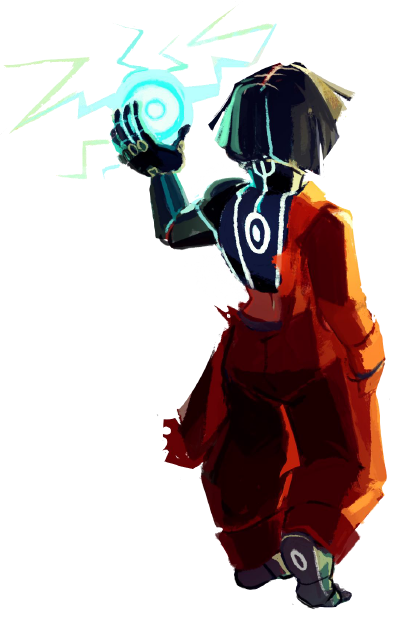
Next up: Putting it all together for chargen.
Making Heroes
Original SA post
Panic at the Dojo: Making Heroes
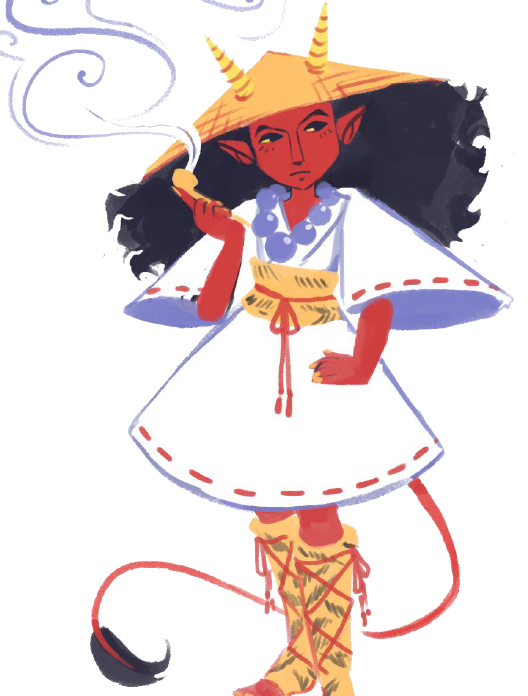
This chapter really should have been at the front of the book! It makes it a bit hard to parse on the first read-through that this overall structure of chargen isn't explained until halfway through the book.
So, step by step, how to make a kung fu hero.
Focused, Fused, or Frantic
The three kinds of heroes - this determines how many Archetypes you get. Focused means you take all three of your Styles from one Archetype, and get a strong, reliable Archetype Ability. Fused means you take two Styles from one Archetype and one from a second, and you get two Archetype Abilities, but each one is half as strong. Frantic means you get three Styles from three different Archetypes, and you don't build Stances - instead, you just pick one Archetype, one Style, and one Form each turn, and then you have to change it up every turn.
There's an optional rule here to forbid any two players from picking the same Style.
Stances
Now, it's time to build your basic fighting style! Pick three Styles, based on whether you're Focused, Fused or Frantic. Then, apply each one to a Form - each Form has to be distinct, so no doubling up. Now you have your Stances, and you pick one of those at the start of each turn to determine what you can do that turn.
The chosen Forms also provide your Skills. Each Form has a related Skill, and you get all three of those; however, if you don't like, you can replace one of them with a Skill from a Form you don't have. Your last Skill comes from writing down a two-word description of your character.
Build
This is one last extra layer of character creation to hammer out at the end. It gives a small bonus, and also a different representation for what your HP actually represents in the fiction. Kind of a neat idea!
Agile Build: Your HP is your ability to see things coming, dodging every attack until the one that sends you to 0 HP takes you out all at once. At the start of your turn, gain 2 Speed Tokens.
Bumbling Build: You're lucky, just barely avoiding every attack until your luck finally runs out. At the end of any turn where you took damage, move 1 space.
Mysterious Build: You hide behind smoke and illusions, until it's all been seen through, and then you're doomed. At the start of your turn, place a Copy or a Fog into an empty adjacent space.
Overpowering Build: You deflect, blast, or punch everything that comes your way, until you can't keep up. At the start of your turn, gain 1 Power Token.
Scheming Build: You throw dirty tricks out to thwart every attack until you finally run out. At the start or end of your turn, place a Trap into an adjacent space.
Tough Build: You're so huge that you just take hits to the face and don't care. At the start of your turn, gain 1 Iron Token.
Hero Building Advice
Something this book does in multiple places is provide serious advice about not just how to build a character, but how to build a GOOD character. This one emphasizes two ideas: Stance diversity, and character focus.
Stance diversity means that every one of your Stances should give you something the other two don't. Frantic Heroes do this best, but everyone should consider it - you don't want any two of them to be redundant. A mobility stance is good for getting out of trouble or getting into position - Shadow Form and Dance Form are strong picks. A defensive stance uses something like Control Form or Iron Form when you're in a bad place, and need to be on your guard for a while. Tanking stances (Zen, Reversal, actually also Shadow) are good for Challenging enemies and drawing heat from your allies. Damage stances (Blaster, Power, One-Two) are good for when you need to kill a specific enemy, right now. Support stances (Song, Vigilance, Iron) keep the team together when the shit has hit the fan. Finally, desperation stances (Vigilance, Wild) are for when everything is fucked and you just want to make sure you take the enemy down with you.
Character focus is the other end of the balancing act - you want lots of your abilities synergize with each other. The book explains this one through a Focused Winterblossom character - at the start of each turn, you hand out a Weakness Token every turn, so you want to build Stances that capitalize on this and reinforce it. Mobility and high range are useful, tanking is good for keeping enemies close to you, defensive stances are bad because you don't want enemies to keep away from you. The Winterblossom Styles tend to give you good range by default, but you want Forms that build into that by giving you tools for getting people into your range - Control or Blaster Form for extra range, Shadow or Reversal Form for out-of-turn mobility to stick to your mark. Pick one thing, then be good at it.
Sample Characters
We get three! One Focused, one Fused, one Frantic. I'm just going to go over one, so here they are:
PATTY NORTH
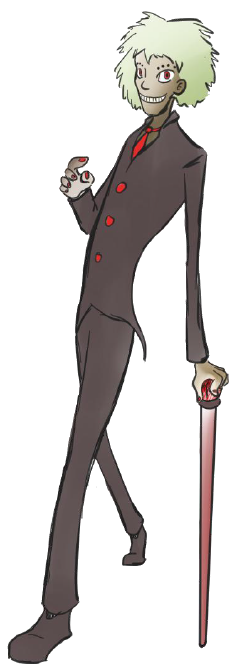
A little more fluff would've been nice for these characters, but here we get our first, a defensive support character who loves the thrill of a good bet more than the thrill of a fight. They go with the Teacher Archetype and Mysterious Build, combined into the Mysterious Teacher ability - at the start of their turn, they place a Copy or Fog into an adjacent empty space, and at the end of their turn, they gain 2 Inspired Tokens, which they can spend to add a d8 to an ally's Action Pool. For their Skills, they take Unmovable and Professional, but swap Unstoppable out for Perfect Timing, then add Eccentric Gambler for the last slot.
Training Mountain Stance
Action Dice: d6/d6/d6
Range: 1
One of the two support stances that will define their role as the back row ally who only intercedes directly as needed. They have Armor, but can only attack in melee, and half of their Speed Tokens get transformed into Iron Tokens. At the end of their turn, they give a Training Token to an ally, which can be spent to raise all the numbers in an Action's description by 1. A nice bit of synergy here: the Mountain unique actions are all Choose X, and that means that Training Tokens let them choose results at once in addition to making those results stronger.
3+: Watch Closely
Gain a Training Token. If you spend it before the end of the turn, give an ally a Training Token.
3+: Secure
Choose two: Gain 3 Iron Tokens, give an ally within range 2 Iron Tokens, heal someone within range.
3+: Contain
Choose two: Pull an enemy two spaces, Challenge an enemy you can see, place a Trap into a space within range.
6+: Protect
Choose four from the Secure and Contain lists.
Mastermind Control Stance
Action Dice: d10/d8/d6/d4
Range: --
Patty is all about letting the rest of the team shine, so why not give them your actions directly? In this stance, Patty takes no actions, instead spending her Action Pool to make allies take their actions for them. After each Action an ally performs on their turn, they can move one space. In this stance she also uses Control Tokens - she can spend one at any time to negate an enemy action, or two to redirect it to a new target.
3+: Suppression
Gain 1 Control token and move one space.
6+: Gain 1 Control token.
9+: Gain 1 Control token and move one space.
Notably, the Mastermind Style means that when they do this, it's one of their allies who gains the Control Tokens, not them.
Elder Power Stance
Action Dice: d10/d10/d4
Range: 1-2
Being a support commander type is all well and good, but sometimes you really do just have to hit someone really hard. In this stance, Patty can spend up to 3 Power Tokens on every hit, and can use any Unique Action from any of their Stances for free once per turn. If it's Tiered, it assumes a 7 was spent on it.
2+: Yell
Gain 3 Power Tokens.
5+: Crush
Deal 3 damage to an enemy within range. It can't be reacted to, reduced, or prevented in any way.
8+: You can spend any number of Power Tokens on this hit.
From there, we get two more sample heroes - Truth Crimson, the Agile Angel/Demon Fused Hero who fights with the Halcyon Beast, Vampire Eternity and Winged Moon stances; and Pompadour Rex, the Bumbling Frantic Punk/Cavalry/Underdog who does whatever the hell he wants.
Next: Enemy building.
Making Villains
Original SA post
Panic at the Dojo: Making Villains
There are three types of enemy NPC builds! The power of each one is measured in 'units', with the design intent that an equal battle should have the name number of units as there are heroes.
- Warriors are your standard one-unit enemy fighters. In terms of raw power, each one is about equivalent to one Hero, but they have less flexibility.
- Stooges are groups of weak loser enemies who are easy and fun to mop the floor with. They have special rules surrounding them, and a group of three to six Stooges is worth one unit, depending on their fighting style.
- Bosses are the big end-of-arc bad guys, who can take on a whole party of PCs alone. They have multiple healthbars, and are worth multiple units.
Warriors
The easiest type of enemies to make, requiring no special rules. They're like pared-down Heroes - each gets one Stance and one health bar. Pick a Style, pick a Form, combine them, then pick any Fused Archeytpe Ability (doesn't have to match their Style) or Boss Archetype Ability (more on that in a bit). They get a Skill from their Form, and don't get a Build.
That's it! They're reasonably strong, but having only one Stance, they have more weaknesses that clever PCs can exploit.
Stooges
A group of Stooges collectively count as one enemy, and take up a number of spaces on the map. To figure that number out, make a Stance for them to fight in - the number of Action Dice they get is the number of spaces they occupy. Each Stooge can only take one Action per turn, so you basically roll X dice, then use each die to make one of the Stooges do something. Stooges get a Build (usually Bumbling) but not an Archetype Ability, and whenever a Stooge uses an action to move, all of the Stooges can move at once. If you end up with more Action Dice than you have Stooges to use them, the remaining dice must all be spent on this Stooge-specific move:
1+: Reinforcements
Heal, then place a Stooge anywhere in play. This uses the new Stooge's action for the turn.
Stooges share HP, all going down at the same time when the squad's health bar runs out. If one of them is Taken Out, they don't return to the fight next round like other characters - they're just gone, and can only restock by using Reinforcements. There's an option for Super Stooges in here - they have two Health Bars, take two turns accordingly, and get a Fused Archetype Ability. Stooges also can't have Copies, so if a Stooge would be Copied, just add another Stooge to the pile instead.
Endless Stooges are a special rule for when the party is fighting an unending horde of idiots while trying to defeat someone else. In this case, Reinforcements is tossed out, and any damage dealt to a Stooge removes it from play. However, at the start of the Stooge's turn, it automatically restocks a number of Stooges equal to the heal value, placed adjacent to any Edge or Obstacle.
Bosses
The big bads. Bosses have multiple health bars, take multiple turns, and count as multiple units. The numbers for all of those depends on how much enemy power they have backing them up - as always, the number of health bars in the fight should be equal on both sides. So, if you have five PCs, and two Stooge groups, then the Boss would have three health bars. Interestingly, this means that a Boss who's fighting alone is actually *stronger* than a boss who's brought his friends to the party, because Boss turns are more dangerous than Warrior or Stooge turns.
Bosses get an Archetype, the Fused Archetype Ability for that Archetype, and one of their three Stances must use a Style from that Archetype. In addition, they have access to Boss Archetypes for this choice, which are special enemy-only Archetypes for Bosses and Warriors. Bosses don't get (or need) a Build, get Skills the same way as PCs, and whatever Action Dice their Stances have, they add an extra d4 to each.
Beyond all that, Bosses have one unique benefit and one unique limitation. The benefit is that if a Boss is thrown off an Edge, they return to play instantly at the start of their next turn, taking 3 damage instead of losing their turn. The limitation is that, like Frantic Heroes, they can never use the same Stance two turns in a row.
Boss Archetypes
These are simpler than regular Archetypes. Each has a Boss Archetype Ability, and four Styles from the main Archetype list that it's associated with. Let's get through those things real quick!
The Blur
After you perform an Action, move one space.
Styles: Jumping, Lightning, Rocket, Winged
The Immortal
The first time each turn that you deal damage with an Action, you heal.
Styles: Elder, Phoenix, Vampire, Vortex
The Giant
You take up a 2x2 space on the grid, and max range goes up by 1. You can move over Walls, turning them into Rubble, at the cost of one extra Speed Token.
Styles: Knockdown, Ogre, Overwhelming, Whip
The Necromancer
At the start of your turn, place a Copy into an empty space. At the end of your turn, all your Copies can move one space, then each Copy deals 1 damage to one adjacent enemy.
Styles: Charging, Mastermind, Spirit, Zombie
The Swarm
At the end of your turn, for each Copy in play, choose one: Gain 1 Power Token, gain 1 Iron Token, move 1 space, all your Copies move on space, destroy a Copy and deal 1 damage to each enemy adjacent to it.
Styles: Crystal, Illusion, Ten Thousand, Syphon
The Tank
When you are pushed or pulled, move one less space.
Styles: Artillery, Aura, Caged, Unbreakable
The Untouchable
At the start of your turn, gain one Control Token. When you spend one to counter an action, the action targets its user in addition to its other targets.
The Vehicle
The GM puts a shape on the field, and that's the shape of the character. Enemies and allies can move on top of you. When you move, everyone on top of you moves with you. Spaces inside of you are always in your Range. Can destroy walls as per the Giant.
Styles: Explosion, Machine, Precision, Ricochet
Next: A little encounter design, a lot of monsters.
Enemy Forces
Original SA post
Panic at the Dojo: Enemy Forces
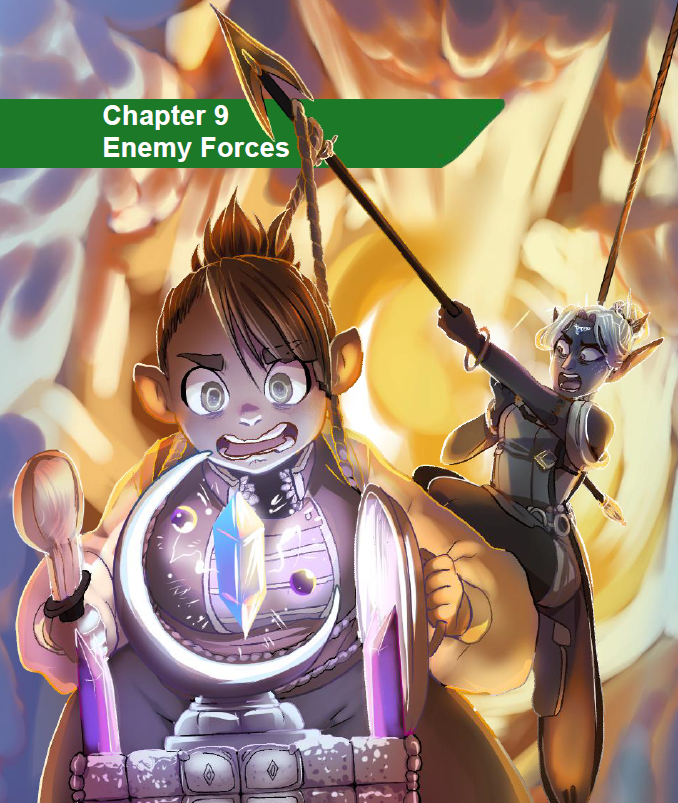
I have no idea what's going on there. Is that a spoon knife?
Designing Encounters
I covered this a bit early, but generally speaking, the rule of encounter design is to have the same number of health bars on each side. PCs (usually) have one health bar, so if you have five PCs, you should have five health bars worth of enemies. Warriors, generally speaking, have one health bar, as do non-super Stooges, so unless there's a boss, "Stooge groups + Warriors = PCs" is a pretty good bet. If you want to have fewer enemies, you can give them extra health bars to compensate. If you want to have more enemies (even counting each group of Stooges as one enemy), then give the PCs extra health bars until it's even again. Each health bar means one turn per round, so tougher characters also get more actions. From there, it's just a matter of choosing the Cinematic Weight and calling it good.
Enemies
So, the remaining part of the book - almost half of it - is a monster manual. It's split up by Archetypes, and each Archetype gets two Stooges, two Warriors, and a Boss. On top of that, the Boss Archetypes add eight Warriors and four Bosses total, and then there's seven Kickstarter backer bosses at the end. That's almost 80 entries, so I'm going to skip most of this and just drop in some highlights.
THE CHOIR (4 Angel Stooges)
Build: Bumbling (At the end of any turn where you took damage, move 1 space)
Annoying distractions. They stack up shields on themselves, punish you for attacking them, and use their Symphonies to heal their allies if ignored. Damned if you do, damned if you don't. As a Stooge, they only get one Stance, so...
Singing World Stance
Action Dice: 7/5/3/1
Range: 2-4
Can hold multiple Shields at a time, and deals 1 damage to any enemy that damages their Shields. Gains a 2-point Shield at the start and end of their turn. After each performed Action, active Shield strengh goes up by 1.
3+: Focus
Gain a 2-point Shield and move one space.
7: Gain a 4-point Shield and move two spaces.
Destroy Active Shield: Symphony
Choose two: Pull an ally 3 spaces, an ally within range heals, Challenge an enemy within range, push an enemy within range 3 spaces, destroy an obstacle within range.
1+: Reinforcements
Heal, then place a Stooge anywhere in play. Uses up the new Stooge's action.
ZOMBIES (4 Demon Stooges)
Build: Tough (at the start of their turn, they gain 1 Iron Token).
You know the deal. It's zambies! Hard to keep down, constantly regenerating, causing groups of four to nine survivors to make bad decisions in TV shows, movies, and video games everywhere. The healing at 3 or less HP notably triggers even if they're at 0 HP.
Zombie Heart Stance
Action Dice: d6/d6/d6/d6
Range: 1
Armor. At start of turn, heals if under 3 HP, then either heals or discards a token. At end of turn, gives a Weakness Token to an enemy in range.
1+: Bow Down
Give a Weakness Token to an enemy within range.
4+: Give two Weakness Tokens to an enemy within range.
1+: Stand Strong
Heal yourself or an ally you can see.
4+: Heal yourself or a different ally you can see.
4+: Hunger
Deal 2 damage to an enemy within range. You may take a token from the target.
1+: Reinforcements
Same as all Stooges.
SIDEKICK (Cavalry Warrior)
A character built specifically to prop up another, stronger character. Sticks to the target like glue, protects them, and generally makes their presence everyone else's problem until taken out.
Ability: At the end of your turn, you and each adjacent ally gain a 2-point Shield.
Skills: Perfect Timing
Heroic Time Stance
Action Dice: d8/d8/d6/d4
Range: 1-2
Armor. Doesn't discard Speed Tokens or Action Dice between turns, but can only take one Action per turn. Whenever an ally within range takes damage, takes half of it for them.
1+: Counter Attack
Teleport within range of an enemy that dealt damage to you this turn, then spend thsi number on another Action targeting that enemy.
4+: Burning Heart
You and each ally within range gain 2 Iron Tokens.
ZERO TROUBLES (Cyborg Boss)
A perfect battle android. Never makes a mistake, never shows any mercy.
Ability: At start of turn, gains 2 Basic Tokens of your choice.
Skills:Put On A Show, Basically Magic, Perfect Timing, Stoic Android
Rocket Dance Stance
Action Dice: d10/d8/d6/d4
Range: 1
After you Throw or Grapple someone, gain a Speed Token for each space they moved. After each space of movement via Free Movement, may choose someone within range and pull them 1 space (dunno how that's supposed to work with a range of 1). After you push someone, you may teleport to an adjacent space.
3 Speed Tokens: Try And Keep Up
Move two spaces, then heal 2.
2 Speed Tokens: Rocket Tackle
Push an adjacent character two spaces.
Machine Tornado Stance
Action Dice: d8/d8/d6/d4/d4
Armor. Don't discard Speed Tokens or Action Dice between turns, only take one action per turn. Can spend any Basic Token as if it were any other kind of Basic Token.
1+: Counter Attack
Teleport within range of an enemy that dealt damage to you this turn, then spend thsi number on another Action targeting that enemy.
1+: High Efficiency
Choose three: Heal 1, gain an Iron Token, gain a Power Token, gain a Speed Token, deal 1 damage to an enemy within range.
Burning Gold Stance
Action Dice: d8/d8/d8/d4
Range: 2-5
Actions can apply to one extra target within range. After targeting an enemy with an Action, if they have four or less Burning Tokens, give them a Burning Token.
3+: Amplify
Next Action this turn has +2 range and can apply to up to three extra targets.
3+: Shockwave
Deal 1 damage to every enemy within range.
6+: Deal 2 damage to one enemy within range.
4+: Burn It All Down
Give one enemy within range a Burning Token, then put a Trap in their space.
The concept of this setup is that the Machine Tornado Stance builds up power which is then unleashed in the other two Stances. Zero starts in Machine Tornado, using low numbers for High Efficiency and holding onto the large numbers, then switches to Burning Gold Stance to drop Shockwaves or Amplified Burn It All Downs, using Rocket Dance to open up distance and heal, while also ringing enemies out when an Edge is nearby.
Next: Phantom, Flametongue, Punk and Gunkata enemies.
Enemy Forces Part 2
Original SA post
Panic at the Dojo: Enemy Forces Part 2
POLTERGEISTS (3 Phantom Stooges)
Build: Agile (Gain 2 Speed Tokens at the start of your turn).
Annoying harassment stooges who throw things around the battlefield, but don't do much else. A good foil for obstacle-based heroes.
Puppet's Hurricane Stance
Action Dice: d10/d8/d6
Range: 2-3
After you Throw or Grapple someone, gain a Speed Token for each space they moved. After each space of movement, you can choose someone within range and pull them 1 space. Can use Speed Tokens to move allies, enemies or obstacles - Walls and Traps moved become Rubble.
3 Speed Tokens: Try And Keep Up
Move two spaces, then heal 2.
3+: Pull the Strings
Move an enemy or ally you can see 3 spaces.
5+: Do it again.
1+: Reinforcements
Same as all Stooges.
PYROMANIC (Flametongue Warrior)
An enemy who is perpetually on fire, and is sharing this gift with everyone in the immediate vicinity. Uses Ignition every turn that there's an enemy in range, and the Blaster Ability means that it gives Burning Tokens to multiple enemies at once.
Ability: The first time you deal damage to an enemy during your turn, they gain two Burning Tokens.
Skill: Basically Magic
Inferno Dynamo Stance
Action Dice: d8/d8/d8
Range: 1-3
All Actions get one extra target within range. Whenever an enemy attacks you, you can give them all of your Burning Tokens. At the end of your turn, gain three Burning Tokens.
3+: Amplify
Next Action this turn has +2 range and 3 extra targets.
3+: Shockwave
Deal 1 damage to every enemy within range.
6+ Deal 2 damage to one enemy within range.
Gain 1 Burning Token: Ignition
Can only be used once per turn. Give a Burning Token to an enemy within range.
CHATTERBOX (Punk Warrior)
An annoying tank who deals with enemies by never shutting up. Strategy is to taunt and challenge enemies, then be almost impossible to take down.
Ability: At the start of your turn, add X to your Action Pool. X is the amount of damage on your current health bar, or 1 if it's full.
Skill: Eyes Wide Open
Taunting Eternity Stance
Action Dice: d6/d6/d6/d6
Range: 1
At the start of your turn, either discard a token or heal. At the end of your turn, give a Weakness Token to an enemy in range. After taking damage, gain 1 Iron Token, and move one space if the attacker has a Challenge from you.
1+: Bow Down
Give a Weakness Token to an enemy within range.
4+: Give two Weakness Tokens to an enemy within range.
1+: Is That All You Got?
Challenge an enemy you can see, then gain an Iron Token.
X: Not Good Enough
Give X-2 Weakness Tokens to the enemy with your Challenge, then discard the Challenge.
ACES LOW (Gunkata Boss)
A flashy high-ranking enforcer who likes putting on a good show, working for whoever you need them to be working for. Riddles the party relentlessly with small amounts of damage. Eschews gender binary, mercy.
There's art for these characters, but most of it is bad and/or art we've seen before. There are a few exceptions later, so I'll include those ones.
Ability: At the end of your turn, deal 1 damage to all enemies within range.
Skills: Flashy Enforcer, Put On A Show, Think Fast, Professional
Flashy Shuffle Stance
Action Dice: d10/d8/d6/d4
Range: 1
After you Throw or Grapple someone, gain a Speed Token for each space they moved. After each space of movement, you can choose someone within range and pull them 1 space. After rolling Action Dice, you can pick any two and combine them into one bigger number.
3 Speed Tokens: Try And Keep Up
Move two spaces, then heal 2.
X: Show Off
Limit once per turn. Choose two basic actions: Movement, Damage, A Challenger Approaches, Put It Out!, Throw. Use both as if you had spent X on them.
Akimbo Chaos Stance
Action Dice: d6/d6/d4/d4/d4
Range: 3-5
Anytime you deal damage to an enemy with an Action, hit them again for 1 damage. After you damage someone, move one space.
1+: Slide In
Teleport two spaces.
4+: Whirlwind
Deal 1 damage to up to 3 enemies within range.
4+: Firing Wild Deal 1 damage to either all characters adjacent to you, or all characters within range.
Ten Thousand Blizzards Stance
Action Dice: d10/d8/d6/d4/d4/d4/d4 (Jesus fuck)
Range: 2-6
3+: Suppression
Gain a Control Token and move one space.
6+: Gain a Control Token.
9+: Gain a Control Token and move one space.
2+: Point Blank Shot
Deal 1 damage to an adjacent enemy, then push them one space.
Aces is a highly mobile boss who shines when taking on multiple opponents at once. Flashy Shuffle Stance lets them Throw enemies and escape at the same time, Ten Thousand Blizzards Stance gives them Control Tokens for defense, and Akimbo Chaos synergizes with their Archetype Ability to allow insane amounts of movement each turn.
Next: Ninjas.
Enemy Forces Part 3
Original SA post
Panic at the Dojo: Enemy Forces Part 3
NINJAS (6 Trickster Stooges)
Build: Agile (Gain 2 Speed Tokens at the start of your turn).
A must in any martial arts movie. Swarming the battlefield, hard to pin down, damage is minimal. Be much more concerned if you just fight one ninja - there's an Elite Ninja build for that situation that's much more powerful.
Hidden Silence Stance
Action Dice: d4/d4/d4/d4/d4/d4
Range: 1-3
Gain 2 more Speed Tokens at the start of your turn, so 4 total. Keep your Speed Tokens between turns. See and move through walls as if they were empty spaces.
3 Speed Tokens: Stunt
Place a Fog, Copy, or Trap into an adjacent space, then teleport 2 spaces.
1+: Reinforcements
Like all Stooges.
CIVILIANS (4 Underdog Stooges)
Build: Bumbling (At the end of a turn where you took damage, move 1 space).
An interesting concept - civilians aren't much help at all in a fight, but if they're determined to get in the way, they can be a real nuisance. A Stooge likely to show up as allies as well as enemies.
Distracting Time Stance
Dice: d8/d8/d6/d4
Range: 1-2
Armor. Don't discard Speed Tokens or Action Dice between turns. If an enemy deals damage to you and they have no Weakness Tokens, give them a Weakness Token.
1+: Counter Attack
Teleport within range of an enemy that dealt damage to you this turn, then spend this number on another Action targeting that enemy.
1+ or 2 Basic Tokens: Flare
Move 1 space, then give a Weakness Token to an enemy within range.
1+: Reinforcements
Like all Stooges.
HIVEMIND CORE (Teacher Warrior)
Doesn't do much on its own, but gives more options to every other enemy on the field, letting them all fight at 100% strength or more.
Ability: At the end of your turn, gain an Inspired Token. Inspired Tokens let you roll a d8 and add it to an ally's Action Pool on their turn.
Skill: Perfect Timing
Mastermind Panic Stance
Action Dice: d8/d8/d6/d4
Range: N/A
Armor. Keep your Speed Tokens and Action Dice between turns. You can only take one Action per turn, and can't take Actions yourself - instead, pick an Action and make an ally you can see do it instead. After an ally performs an action on your turn, move one space.
1+: Counter Attack
Teleport within range of an enemy that dealt damage to you this turn, then spend this number on another Action targeting that enemy.
There's actually a gotcha with this build - because the Mastermind Style has no range, it's impossible to use Counter Attack. I asked the creators about it, and they said that they should've just not shown the move in the statblock. Basically, Hivemind Core's supposed to just gradually use all of its Action Dice over the turn to let its allies do extra Basic Actions.
DR. APRIL WINTERS (Winterblossom Boss)
Rich, conniving socialite and genuis engineer. Wherever she's found, she's always halfway done with some plan to take over a new business/city/country.
Ability: At the start and end of your turn, give a Weakness Token to one enemy within range.
Skills: Ruthless Socialite, Professional, Put On A Show, Unstoppable
Precision Blade Stance
Action Dice: d10/d10/d4/d4
Range: 1-2
When you gain Speed Tokens, replace half of them with Power Tokens. You can spend up to 3 Power Tokens per hit. Actions deal +1 damage to enemies with Armor or Shields. When you target an enemy, they discard one Iron Token.
3+: Yell
Gain 3 Power Tokens.
6+: Crush
Deal 3 damage to an enemy within range. Damage can't be reduced or reacted to by any means.
9+: You can spend any number of Power Tokens on this.
3+ and 3+: Perfect Strike
Requires two dice to use. Deal 4 damage to an enemy within range. This can't be reduced or reacted to by any means.
Reflected Control Stance
Action Dice: d10/d8/d6/d4/d4
Range: 2-6
At the start of your turn, place up to three Walls into empty adjacent spaces. You can see and target enemies through Walls.
3+: Suppression
Gain a Control Token and move one space.
6+: Gain a Control Token.
9+: Gain a Control Token and move one space.
3+: Walled In
Place 3 Walls into empty spaces within Range 1-3.
3+: Icicle Fall
deal 1 damage to each enemy adjacent to a wall.
Frozen Hurricane Stance
Action Dice: d10/d8/d6/d4
Range: 1
After you Throw or Grapple someone, gain a Speed Token for each space they moved. After each space you move, you can choose someone within range and pull them a space. After an enemy moves into an empty space adjacent to you, give them a Weakness Token.
3 Speed Tokens: Try And Keep Up
Move two spaces, then heal 2.
3+: Exploit Weakness
Deal 2 damage to an enemy within range and give them a Weakness Token.
The idea for April's build is to open with Frozen Hurricane, drag enemies out of position, use Precision Blade to shut them down, then use Reflected Control to bunker up when the heat is on.
Next: A bear.
Unique Enemies
Original SA post
Panic at the Dojo: Unique Enemies
Last update wrapped up the enemies built using player-facing Templates, but this next list are built using the Boss Archetypes, giving them strange powers beyond ordinary PCs.
VAMPIRE (Immortal Warrior)
Rapidly-regenerating attackers who are hard to take down - if they have even one hit point left, they're still extremely dangerous, and they're good at escaping when in serious danger. However, unlike some healers, they can't heal themselves back up from zero.
Ability: The first time you deal damage with an Action each turn, you heal.
Skills: Shadow Walker
Vampire Moon Stance
Action Dice: d4/d4/d4/d4/d4/d4
Range: 1
Gain 2 Speed Tokens at the start and end of your turn. Don't discard Speed Tokens at the end of a turn. Every time you deal damage, heal 1. Whenever you give an enemy Weakness Tokens, gain the same number of Power Tokens.
3 Speed Tokens: Stunt
Place a Fog, Copy or Trap into an adjacent space, then teleport two spaces.
4+: Life Steal
Deal 2 damage to an enemy within range, then give them a Weakness Token.
GRIZZLY BEAR (Giant Warrior)
IT'S A BEAR. PUNCH THE BEAR.
Ability: You take up a 2x2 space on the grid. Maximum Range is 1 higher, and you can move over walls, turning them into Rubble.
Skill: Wind Runner
Knockdown Beast Stance
Action Dice: d10/d6/d6
Range: 1-2
Whenever an enemy damages you, deal 1 damage to them. At the start of your turn, add a d6 to your Action Dice for each of: Your health bar is half empty, someone on your team is taken out, you're holding a non-Basic Token.
2 Basic Tokens: Fury
Deal 1 damage to an enemy, then push them 1 space at the end of the turn. Can only be used 3 times per turn.
4+: Take It On The Chin
Every enemy within range deals 1 damage to you. Deal 3 damage to one of them.
WARLOCK (Swarm Warrior)
A demon summoner, whose "Copies" are actually lesser demons serving them. They summon swarms of underilngs, then use them to Shockwave everyone on the map into oblivion.
Ability: At the end of your turn, for each Copy you have, choose one: Gain a Power Token, gain an Iron Token, move one space, each Copy moves one space, destroy a Copy to deal 1 damage to each enemy adjacent to it.
Skill: Basically Magic
Illusion Star Stance
Action Dice: d8/d8/d8
Range: 1-4
Your Actions can all have an additional target within range. After an enemy deals damage to you while within range of at least one Copy, deal 1 damage to them, or 2 damage if they're in range of at least three Copies. Copies can be spent as Iron Tokens.
3+: Amplify
Next Action has +2 range and +3 targets within range.
3+: Shockwave
Deal 1 damage to every enemy within range.
6+: Deal 2 damage to one enemy within range.
3+: Where Are You Looking?
Place 2 Copies into empty spaces within range.
6+: Do it again.
NEWTON POIROT (Blur Boss)
Natural genus, expert detective and scientist, undefeated boxer. She never misses an opening, and always exploits them to beat her opponents into pudding.
Ability: After performing any Action, move one space.
Skills: Boxing Genius, Think Fast, Eyes Wide Open, Wind Runner
Jumping Hound Stance
Action Dice: d6/d6/d4/d4/d4
Range: 1
At the start and end of your turn, teleport 1-3 spaces. After you deal damage to an enemy with an Action, hit them again for 1 damage.
1+: Slide In
Teleport two spaces.
4+: Whirlwind
Deal 1 damage to up to 3 enemies within range.
4+: Leap In
Teleport 1-3 spaces, then deal 2 damage to an enemy within range.
Caged Bear Stance
Action Dice: d6/d6/d6/d6/d4
Range: 1
At the start of your turn, either heal or discard a token. At the end of your turn, give a Weakness Token to an enemy in range. Adjacent enemies can't gain or spend Speed Tokens.
1+: Bow Down
Give a Weakness Token to an enemy within range.
4+: Give two weakness tokens to an enemy within range.
1+: Stand Strong
Heal yourself or an ally.
4+: Heal yourself or a different ally.
2+: Welcome To My Maze
Deal 1 damage to an enemy outside your range, then pull them three spaces.
Lightning Beast Stance
Action Dice: d10/d6/d6/d4
Range: 1
After you deal damage, gain a Speed Token. At the start of your turn, add a d6 to your Action Dice for each of: Current healthbar is at half HP or less, someone on your team is taken out, you're holding a non-Basic Token.
2 Basic Tokens: Fury
Deal 1 damage to an enemy within range. At end of turn, push them one space. Can only be used 3 times per turn.
2+: Deadly Dance
Teleport 2 spaces, then deal 1 damage to an enemy within range.
5+: Teleport 2 spaces, then deal 2 damage to an enemy within range.
8+: Do 5+ again.
Jumping Hound Stance is Newton's engage, then Caged Bear Stance lets her lock targets in place around her while healing herself to keep the pressure on. Once things are heating up, she can use Lightning Beast Stance to do massive damage and take out the party all at once.
ROSEY "SILVER" BLUEHORN (Tank Boss)
A caped superhero who uses her incredible strength and unbreakable body to find evil and smash evil. Odd choice of character for a boss enemy, but maybe this is a villains game, or maybe she's been brainwashed or just disagrees with the party about something.
Ability: Move one less space when Pushed or Pulled.
Skills: Friendly Local Superhero, Natural Charisma, Unmovable, Unstoppable
Heroic Fortress Stance
Action Dice: d8/d8/d8/d4
Range: 1-2
Whenever you gain Speed Tokens, replace half of them with Iron Tokens. Whenever an ally within range takes damage, you take half of it for them.
3+: Secure
Choose two: Gain 3 Iron Tokens, an an ally within range gains 2 Iron Tokens, heal someone within range.
3+: Contain
Choose two: Pull an enemy 2 spaces, Challenge an enemy, place a Trap into a space within range.
6+: Protect
Choose four from the combined Secure/Contain lists.
4+: Burning Heart
You and every ally in range gains 2 Iron Tokens.
Aura Wave Stance
Action Dice: d8/d6/d6/d4/d4
Range: 1-3
At the start of your turn, choose Iron, Power, or Speed. You gain 3 of that token, every ally gains 1 of that token, and you gain a 3 point shield. If an enemy within range damages a Shield, move them one space. After a Shield within range breaks, gain an Iron Token.
1+: Sing Along
Pick an ally. Choose one: They remove a token they hold, they heal, or they gain 2 tokens from your current song.
4+: The target also picks one from the list.
6+: Add a 4 to their Action Pool, which they must immediately spend on an Action.
Elder Sun Stance
Action Dice: d10/d10/d4/d4
Range: 1-2
Whenever you gain Speed Tokens, replace half of them with Power Tokens. You can spend up to 3 Power Tokens per hit. Once per turn, use any Unique Action you know from any of your Stances, at no cost, as if it were performed with a 7.
2+: Yell
Gain 3 Power Tokens.
5+: Crush
Deal 3 damage to an enemy within range, which can't be reduced or reacted to by any means.
8+: You can spend any number of Power Tokens on this hit.
Silver is a nice and simple boss build. Allies under attack? Heroic Fortress. Allies need a hand? Aura Wave. Evil needs a punch in the face? Elder Sun.
A GODDAMN HELICOPTER (Vehicle Boss)
If you aren't here to karate-chop a helicopter, then what are you even doing with your life?
Ability: You take up a large, shaped portion of the battlefield. Enemies and allies can move on top of you, and when you move, they move with you. You can move over walls, turning them to rubble. Spaces inside of you are always within range.
Skills: Battle Chopper, Basically Magic, Wind Runner, Unstoppable
Ricochet Dynamo Stance
Action Dice: d8/d8/d8/d4
Range: 2-5
Each of your Actions can have one extra target within range. After you deal damage to an enemy with an action, deal 1 damage to a different enemy within 3 spaces of you.
3+: Amplify
Your next Action this turn has +2 range and +3 targets within range.
3+: Shockwave
Deal 1 damage to every enemy within range. (This becomes hilarious when combined with the stance's passive.)
6+: Deal 2 damage to one enemy within range.
3+: Trick Shot
Pick an obstacle within range. Deal 2 damage to an enemy within 3 spaces of that obstacle.
Artillery Rage Stance
Action Dice: d10/d10/d4/d4
Range: 3-8
Whenever you gain Speed Tokens, replace half of them with Power Tokens. You can spend up to 3 Power Tokens per hit. You can see enemies through fog and walls.
2+: Yell
Gain 3 Power Tokens.
5+: Crush
Deal 3 damage to an enemy within range, which can't be reduced or reacted to by any means.
8+: You can spend any number of Power Tokens on this hit.
1+: Bombardment
Place a trap into a space within range.
6+: Place a trap into each space adjacent to the first trap.
Explosion World Stance
Action Dice: 7/5/3/1/d4
Range: 2-4
You can hold multiple Shields at a time. When an enemy damages your Shield, do 1 damage to them. After you damage an enemy, push them one space. After you destroy an obstacle, replace it with an Edge.
3+: Focus
Gain a 2-point Shield and move one space.
7+: Gain a 4-point Shield and move two spaces.
6+: Ka-Boomb!
Deal 2 damage to an enemy within range, then destroy every obstacle adjacent to them.
Next up: The kickstarter bosses.
Kickstarter Bosses (Maybe Lean, Grace Thoruson, Christopher & Christine)
Original SA post
Panic at the Dojo: Kickstarter Bosses (Maybe Lean, Grace Thoruson, Christopher & Christine)
As part of the kickstarter campaign that funded this game, there was a tier where if you donated enough, you could come up with a concept for a boss character, and they would get into the book as a sample character. There are seven in total, so let's see what we got!
MAYBE LEAN (Giant Boss)
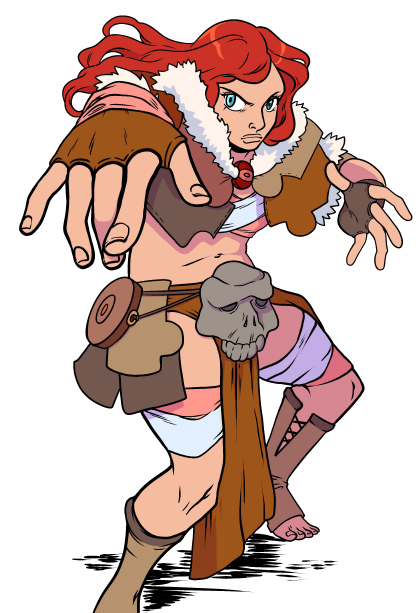
Nine feet tall, shredded, jolly. May won't start a fight, but she'll definitely finish one. She's slow, far-reaching, powerful, and unstoppable. Her build shines best on battlefields with a lot of Edges, so that she can show her enemies the door.
Ability: You take up a 2x2 space on the grid. Maximum Range is 1 higher, and you can move over walls, turning them into Rubble. The Giant archetype was actually created specifically for May to use, actually.
Skills: Friendly Giant, Unmovable, Peaceful Heart, Unstoppable
Knockdown Turtle Stance
Action Dice: d8/d6/d6/d4
Range: 1-2
Armor. When you gain Speed Tokens, replace half of them with Iron Tokens. Whenever you take damage from an enemy, deal 1 damage to them.
3+: Secure
Choose two: Gain 3 Iron Tokens, an an ally within range gains 2 Iron Tokens, heal someone within range.
3+: Contain
Choose two: Pull an enemy 2 spaces, Challenge an enemy, place a Trap into a space within range.
6+: Protect
Choose four from the combined Secure/Contain lists.
4+: Take It On The Chin
Each enemy within range deals 1 damage to you, then you deal 3 damage to one of them.
Ogre's Tornado Stance
Action Dice: d8/d8/d6/d4/d4
Range: 3-8
Armor. Don't discard Action Dice or Speed Tokens between turns. You only take one Action per turn. Throws can target any number of enemies within range, and after you Throw an enemy, they take 1 damage.
1+: Counter Attack
Teleport within range of an enemy that dealt damage to you this turn, then spend the number on another Action targeting them.
3+: Watch Your Step
Deal 2 damage to an enemy that moved this turn.
Lucky Lotus Stance
Action Dice: 7/5/3/1/d4/d4
Range: 2-4
Armor. You can hold multiple Shields at a time. When an enemy damages your Shield, do 1 damage to them.
3+: Focus
Gain a 2-point Shield and move one space.
7+: Gain a 4-point Shield and move two spaces.
3+: Just What I Needed
Choose one: Gain 2 Basic Tokens, teleport 2-3 spaces, heal. You can spend 2 Basic Tokens to choose a second option, or 3 to choose all three.
GRACE THORUSON (Wardancer Boss)
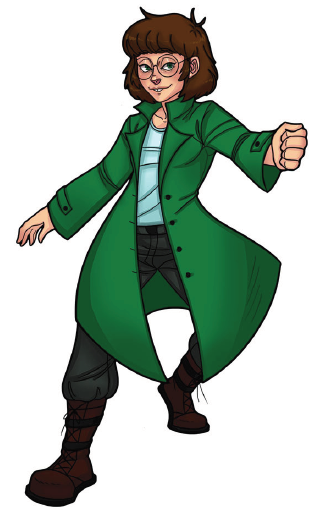
A tranquil warrior who seeks self-perfection and inner peace, but who also expresses herself primarily via violence. Violence for its own sake is bad, but violence to perfect your skills is essential. In a fight, she's extremely mobile, teleporting around the battlefield at random while using stuns to lock down more dangerous opponents.
While Grace uses a regular Archetype, her Stunning Style is unique to her, using Stun Tokens that only she has access to. She uses them to lock down enemies, taking away some of their actions.
Ability: After rolling your Action Dice, increase two of your numbers by 2.
Skill: Tranquil Warrior, Peaceful Heart, Think Fast, Unstoppable
Stunning Moon Stance
Action Dice: d4/d4/d4/d4/d4/d4/d4
Range: 1
At the start and end of your turn, gain 2 Speed Tokens. Don't discard Speed Tokens between turns. At the end of your turn, give one Stun token to an enemy within range.
Stun Tokens: After rolling your Action Dice at the start of your turn, for each Stun Token you have, reduce a number by 4. Remove any numbers below 1, then discard all your Stun Tokens. Someone can't hold more than three Stun Tokens at a time.
3 Speed Tokens: Stunt
Place a fog, copy, or trap into an adjacent space, then teleport two spaces.
4+: Stunning Fist
Give a Stun Token to an enemy in range.
Weightless Sun Stance
Action Dice: d10/d10/d4/d4
Range: 1
When you gain Speed Tokens, replace half of them with Power Tokens. You can spend up to 3 Power Tokens per hit. All spaces count as empty spaces to you, Rubble doesn't make you discard Speed Tokens, Traps don't damage you, and Edges can't remove you from play.
3+: Yell
Gain 3 Power Tokens.
6+: Crush
Deal 3 damage to an enemy within range. This damage can't be reduced or reacted to by any means.
4+: Effortless
Teleport to any space you can see.
7+: Target ally can teleport to any space they can see.
Slasher Sky Stance
Action Dice: d6/d6/d4/d4/d4
Range: 1
After dealing damage to an enemy with an Action, hit them again for 1 damage. At the end of every turn, deal 1 damage to an adjacent enemy.
1+: Slide In
Teleport two spaces.
4+: Whirlwind
Deal 1 damage to three enemies within range.
4+: Suddenly...
Teleport into an empty space adjacent to someone who doesn't have anyone else adjacent to them.
CHRISTOPHER AND CHRISTINE (Twins Boss)
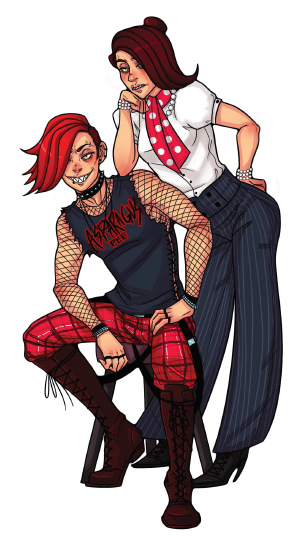
Two twins linked by a telepathic bond. Christopher is a crude punkass jerk, and Christine tries (sometimes even with some success) to be a little more classy. They can fit anywhere in the plot as needed, as the enemy mastermind or just as the mastermind's elite bodyguards.
Chris & Chris use a unique Archetype, created only for them: Twins, which lets them be in two places at once, while working together as a single unit. They're agile and favor lots of hits over individual heavy attacks. They're strongest when they're together, but can also spread out for the tactical advantage of being in two places at once.
Ability: You occupy two spaces, one for each twin. After one twin moves, the other can move one space. When the twins perform an action, either one can perform it. They count as each other's Allies and can target each other accordingly, and if one twin deals damage to an enemy with an Action, if that enemy is within range of the second twin, they get hit again for 1 damage. An attack that manages to hit both twins does do double damage to their shared health bar.
Skills: Two Places At Once, Twin Telepathy, Natural Charisma, Professional
Charging Star Stance
Action Dice: d8/d8/d8/d4
Range: 1-2
Your Actions can all have an additional target within range. At the start of your turn, move 2 spaces. At the start of each ally's turn, they can move 2 spaces.
3+: Amplify
Next Action has +2 range and +3 targets within range.
3+: Shockwave
Deal 1 damage to every enemy within range.
6+: Deal 2 damage to one enemy within range.
3+: Follow My Lead
Move one space, then deal 1 damage to an enemy within range. An ally you can see may move one space, then deal 1 damage to an enemy within their range. This does apply to the twins themselves, allowing them to use this attack to deliver four 1-damage hits with a single die.
Shining Song Stance
Action Dice: d8/d8/d6/d4/d4
Range: 1
At the start of your turn, choose Iron, Power, or Speed. You gain 3 of that token, and every ally gains 1 of that token. At the start of your turn, all obstacles and enemies adjacent to you are pushed one space. Enemies cannot move into spaces adjacent to you.
Because the twins are their own allies, they get a total of four tokens of the chosen type.
1+: Sing Along
Pick an ally. Choose one: They remove a token they hold, they heal, or they gain 2 tokens from your current song.
4+: The target also picks one from the list.
6+: Add a 4 to their Action Pool, which they must immediately spend on an Action.
1+: Beacon
Pull one ally up to three spaces. You and that ally heal 1.
4+: That ally heals.
Rallying Watcher Stance
Action Dice: d10/d8/d6/d4/d4
Range: 1-4
At the end of your turn, you and each ally within range heals. At the start of each ally's turn, if they are within range of you, they heal. If the twins wind up in each other's range, they heal twice.
3+: Suppression
Gain a Control Token and move 1 space.
6+: Gain a Control Token.
9+: Gain a Control Token and move 1 space.
2+: Group Up
Pull an ally up to 3 spaces.
3+: Pull an ally up to 4 spaces.
5+: Each pulled ally heals.
Next: The last update.
Kickstarter Bosses (Ahmose Sitkamose, Big Jay, Project Meteor, Princess Ruin)
Original SA post
Panic at the Dojo: Kickstarter Bosses (Ahmose Sitkamose, Big Jay, Project Meteor, Princess Ruin)
Final stretch!
AHMOSE SITKAMOSE (Necromancer Boss)
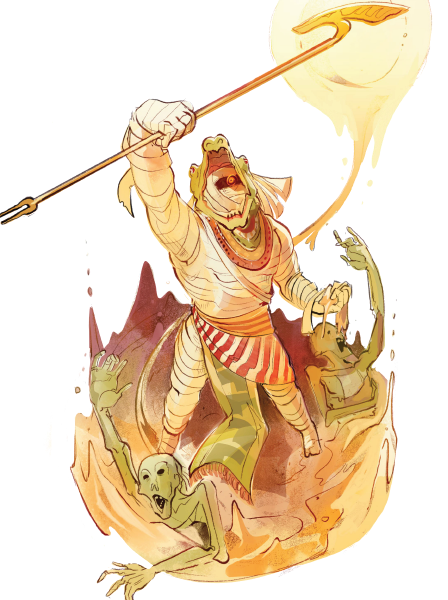
An evil pharaoh from ancient times, resurrected by two museum interns arguing over the pronunciation of the hieroglyphics in his magic tome of darkness. He can be the serious mastermind, a goofy underling of the real villain, or whatever else you want - a proper all-purpose boss fight.
Just as the Giant archetype was built for May, the Necromancer archetype was built for Ahmose. He uses swarm tactics, flooding the board with zombies that do his fighting for him and creating fog to hide his growing army.
Ability: At the start of your turn, place a Copy into an empty space you can see. At the end of your turn, each Copy moves one space, then deals 1 damage to an adjacent enemy.
Spirit Circle Stance
Action Dice: d10/d8/d6/d4
Range: 1-3
After you Throw or Grapple someone, gain a Speed Token for each space they moved. After each space of Free Movement, pull someone in range one space. Edges can't remove your Copies from play, and they treat Walls as empty space. After you move yourself or a Copy with Free Movement, you can move any number of Copies one space.
3 Speed Tokens: Try And Keep Up
Move two spaces, then heal 2.
1+: Now You See Me...
Place a Copy into an empty space within range.
3+: Do it again.
5+: Do it again.
Destroy 1 Copy: ...Now You Don't
Teleport into the space of the destroyed Copy.
Dark Star Stance
Action Dice: d8/d8/d8/d4
Range: 2-5
All Actions can apply to one extra target within range. You can see and target through Fog. At the end of your turn, put a Fog on your space.
3+: Amplify
Next Action has +2 range and +3 targets within range.
3+: Shockwave
Deal 1 damage to every enemy within range.
6+: Deal 2 damage to one enemy within range.
4+: Darkness Dawns
Place two Fogs into empty spaces within range, then you can teleport to one of them.
4+: Twilight Sorrow
Every enemy standing in Fog gains one Weakness Token. Gain a Speed Token for each.
Zombie Silence Stance
Action Dice: d4/d4/d4/d4/d4/d4/d4
Range: 1
Armor. At the start and end of your turn, gain 2 Speed Tokens. Don't discard Speed Tokens between rounds. At the start of your turn, heal if your HP is 3 or less.
3 Speed Tokens: Stunt
Place a Copy, Fog or Trap into an adjacent space, then teleport two spaces.
4+: Hunger
Deal 2 damage to an enemy within range, then take one of their tokens.
BIG JAY (Punk Boss)
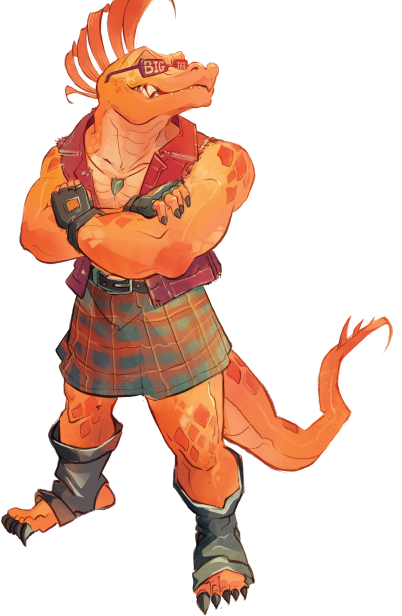
Easily the best illustration in the book. Look at that motherfucker.
Big Jay is a big dragonman in a small world. Loves gold, breathes fire, wants to be ripped and have power and money. If you threaten them, he'll beat you up. He won't help you unless there's something in it for him, and he'll turn on you the instant there's something in it for him to turn on you.
Like most of the kickstarter bosses, he has a unique mechanic - in this case, the Dragon's Ego Stance. It uses a unique set of actions and abilities, combining aspects of Incinerator Style, Blaster Form, and Power Form. His moveset involves hitting as many enemies at once as he can, and spreading massive numbers of Burning Tokens along with his attacks. He also has a unique skill, Dragon Powers, that lets him leverage armored scales, fire breath, a big pile of gold, and an even bigger ego.
Ability: At the start of your turn, add X to your Action Pool, where X is the damage on your current health bar, or 1 if it's full.
Skills: Gang Leader, Dragon Powers, Basically Magic, Unstoppable
Dragon's Ego Stance
Action Dice: d10/d10/d10(/d4? The book doesn't list it but I think there should be a d4 here, since he's a boss)
Range: 1-2
When you spend Power Tokens to boost the damage of an attack, give the target a Burning Token. You can spend any tokens you hold as Power Tokens, and can spend up to 2 Power Tokens per hit.
2+: Dragon Fire
Give a Burning Token to an enemy within range.
5+: Give a Burning Token to that enemy and each enemy adjacent to them.
8+: Give a Burning Token to that enemy and each enemy within their range.
3+: Dragon Slam
Deal 1 damage to each adjacent enemy.
6+: Deal 1 damage to each enemy within range.
9+: Deal 1 damage to each enemy you can see.
Burning Dragon Stance
Action Dice: d8/d8/d8/d4
Range: 2-5
Your Actions can all have an additional target within range. After you target an enemy with an Action, give them a Burning Token if they have 4 or less Burning Tokens.
3+: Amplify
Next Action has +2 range and +3 targets within range.
3+: Shockwave
Deal 1 damage to every enemy within range.
6+: Deal 2 damage to one enemy within range.
4+: Burn It All Down
Target an enemy within range. Give them one Burning Token and put a Trap into their space.
Brawling Sun Stance
Action Dice: d10/d10/d4/d4
Range: 2-4
When you gain Speed Tokens, replace half of them with Power Tokens. You can spend up to 3 Power Tokens per hit. Gain a Power Token whenever your Shield breaks. Whenever you deal damage without spending a Power Token, gain a Power Token.
3+: Yell
Gain 3 Power Tokens.
6+: Crush
Deal 3 damage to an enemy within range. This damage can't be reduced or reacted to by any means.
2 Power Tokens: Tough It Out
Gain a 2-point Shield.
M3-70: PROJECT METEOR (Swarm Boss)
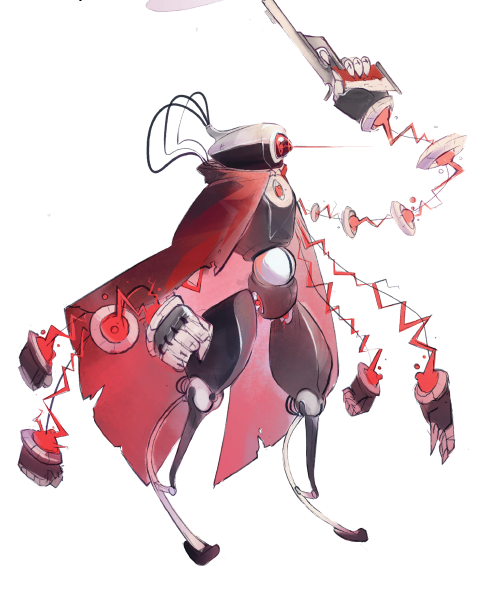
Project Meteor is a secret project to create a robot that can go toe to toe with an entire army. It was a success, but it escaped, and now wanders the world as a rogue AI trying to find its purpose in the world. Its magnetic limbs can split off and move independently around the battlefield, letting it fight from everywhere at once. The Swarm archetype was built for M3-70, with its Copies representing its limbs, which fly back and reattach to the main body when defeated.
Ability: At the end of your turn, for each Copy in place, choose one: Gain a Power Token, gain an Iron Token, move one space, each of your Copies moves 1 space, destroy a Copy to deal 1 damage to each adjacent enemy.
Skills: Splitting Robot, Professional, Shadow Walker, Think Fast
Crystal One-Two Stance
Action Dice: d6/d6/d4/d4/d4
Range: 1
Whenever you deal damage with an Action, hit the target again for 1 damage. Whenever a Copy is destroyed, deal 1 damage to each enemy adjacent to it.
1+: Slide In
Teleport two spaces.
4+: Whirlwind
Deal 1 damage to up to three enemies within range.
3+: Splinter
Place a Copy into a space within range, then deal 1 damage to every enemy adjacent to it.
6+: Do it again.
Free: Shatter
Destroy one of your Copies and give each enemy adjacent to it a Weakness Token.
Illusion Control Stance
Action Dice: d10/d8/d6/d4/d4
Range: 1-5
When an enemy within range of a Copy deals damage to you, deal 1 damage to them, or 2 damage if they're within range of at least 3 Copies. Copies can be spent as Iron Tokens.
3+: Suppression
Gain a Control Token and move one space.
6+: Gain a Control Token.
9+: Gain a Control Token and move one space.
3+: Where Are You Looking?
Place 2 Copies into empty spaces within range.
6+: Place 2 more Copies into empty spaces within range.
Machine Shadow Stance
Action Dice: d4/d4/d4/d4/d4/d4/d4
Range: 2-4
At the start and end of your turn, gain 2 Speed Tokens. Don't discard Speed Tokens between turns. You can spend every Basic Token as if it were any other Basic Token.
3 Speed Tokens: Stunt
Place a Fog, Copy, or Trap into an adjacent space, then teleport two spaces.
1+: High Efficiency
Choose three: Heal 1, gain an Iron Token, gain a Power Token, gain a Speed Token, deal 1 damage to an enemy within range.
4+: Do all five instead.
PRINCESS RUIN (Untouchable Boss)
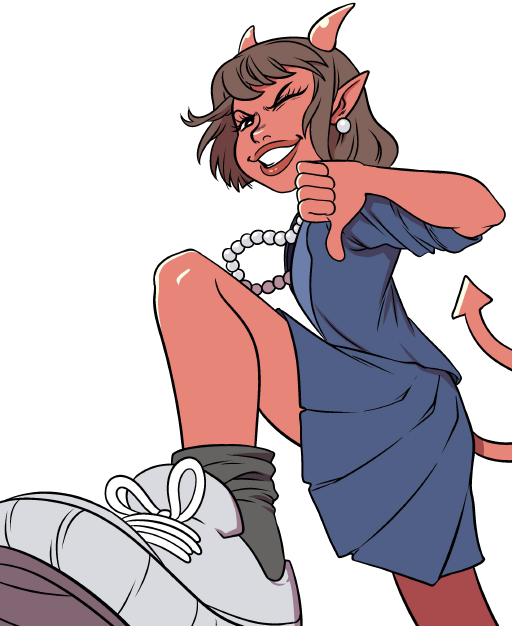
Demon queen from hell who's having a blast running a crime syndicate on Earth. Has mysterious powers that give her sway over her mortal underlings, and loves nothing more than using would-be heroes as pawns in her own sinister plans. As the origin of the Untouchable Archetype, Ruin keeps enemies shut down and fights without getting her hands duty, all while surrounding herself with traps and turning enemy attacks against each other.
Ability: At the start of your turn, gain a Control Token. When you Counter an Action, it targets its user in addition to any other targets.
Skills: Demon Queen, Natural Charm, Basically Magic, Professional
Frozen Song Stance
Action Dice: d8/d6/d6/d4/d4
Range: 1
At the start of your turn, choose Iron, Power, or Speed. You gain 3 of that token, and every ally gains 1 of that token. At the start of your turn, all obstacles and enemies adjacent to you are pushed one space. Enemies cannot move into spaces adjacent to you.
3+: Secure
Choose two: Gain 3 Iron Tokens, an an ally within range gains 2 Iron Tokens, heal someone within range.
3+: Contain
Choose two: Pull an enemy 2 spaces, Challenge an enemy, place a Trap into a space within range.
6+: Protect
Choose four from the combined Secure/Contain lists.
4+: Take It On The Chin
Each enemy within range deals 1 damage to you, then you deal 3 damage to one of them.
...I'm pretty sure this action list is a mistake - none of them belong to the Song Form or Frozen Style.
Pressure Blizzard Stance
Action Dice: d10/d8/d6/d4/d4
Range: 1-5
At the start of your turn, give a Weakness Token to every enemy within range.
3+: Suppression
Gain a Control Token and move one space.
6+: Gain a Control Token.
9+: Gain a Control Token and move one space.
5+: Apply Pressure
Deal damage to an enemy within range equal to the number of tokens they hold. Can only be used once per turn.
Misfortune's Blaster Stance
Action Dice: d8/d8/d8/d4
Your Actions can all have an additional target within range. When you would take damage from a Trap, deal it to an enemy within range instead. If no enemies are within range, gain a Power Token instead.
3+: Amplify
Next Action has +2 range and +3 targets within range.
3+: Shockwave
Deal 1 damage to every enemy within range.
6+: Deal 2 damage to one enemy within range.
1+ or 3 Basic Tokens: Bad Luck
Place a Trap into a space within range.
And that's it! From there we have a backer list, a glossary/index, a one-page printout of Basic Actions, and the other half of the cover image. I think if there's anything more I would have liked, it would be advancement rules or a sample adventure, but this is a budget project, so fair enough.
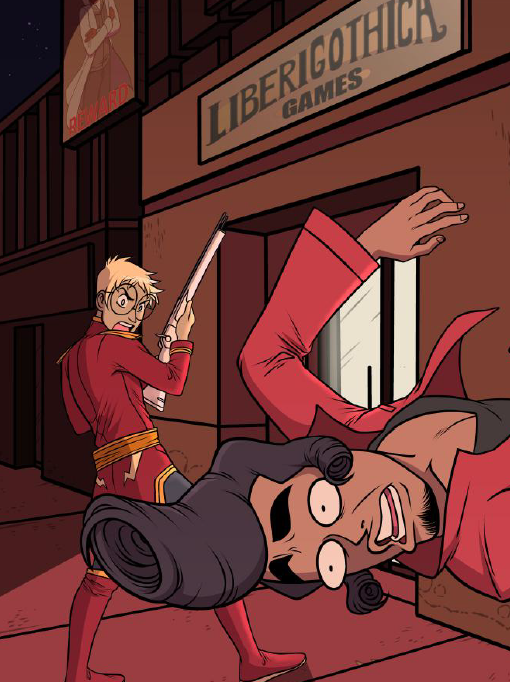
Coming out soon. Put your money in it.